Glass Manufacturers’ Marks (logos, trademarks, emblems, markings, hallmarks, signatures) seen on antique and vintage bottles, fruit jars, insulators, tableware and other types of glassware, M through R listings ~ Note: for introductory and explanatory comments and discussion concerning this alphabetical mark listings section of the website, please click on the “A-B” link below which points to “page one”. Thank you!
[ A – B ] [ C – D ] [ E – L ] [ M – R ] [ S – Z ]
- M……………………………………on the bottom of machine-made cobalt blue jars and bottles, usually Maryland Glass Corporation, Baltimore, Maryland (1907-1980). Exact period of use is uncertain, but verified on the base of cobalt “Milk of Magnesia” bottle from circa 1940-1950. Most Maryland Glass bottles, if they carry a mark, have the “circled M” on the base (see that entry). If a bottle with a “plain M” is a medicine bottle and was made in cobalt blue colored glass, it is almost certainly a product of Maryland Glass. (Please see next entry).
- M…………………………………… a plain “M” is also seen on the base of certain mouth-blown amber, aqua and clear beer bottles (and a smooth-lip amber handmade salve or cold cream jar, photo below) that appear to date c. 1880-1910, and the glassmaker in those cases predates Maryland Glass and to my knowledge has not been identified with absolute certainty. (For instance, some beer bottles marked “F. & P. BOCHART, NEW ALBANY, IND” are marked with a plain “M” on the bottom, and those would date sometime between 1890 and 1907, judging from the years that bottler was in business). That unidentified glass manufacturer was probably located somewhere in the Midwest, i.e. IL, IN, OH or PA. There were a number of bottle factories just in those states with a name beginning with “M”, which shows why it is so hard to know for certain who the maker of those bottles was. Researcher Bill Lockhart believes that Massillon Glass Works, of Massillon, Ohio (1881-1904) could be the source of the “M” mark on beer bottles. Some of the “M” marks appear with numbers or letters (see my “M B” entry on this page). For in-depth information on the marks attributed to that glassmaker (also known as Reed & Company), see this .pdf article: https://sha.org/bottle/pdffiles/BandE22-2.pdf There is also a good possibility that this “plain M” indicates Modes Glass Company of Cicero, Indiana (1894-c. 1902), since examples of “F. & P. Bochart, New Albany, Ind” beer bottles have been found with both (either) a “plain M” OR an “M G CO” marking which, in the latter case, almost certainly indicates Modes Glass Company (see my page on M.G.Co. bottles here) : M.G.CO. marks on antique bottles & fruit jars (Mississippi, Missouri, Modes) . Thus I feel that the “M” mark may indicate the very same manufacturer that made those “M G CO” bottles for Bochart. NOTE: In some cases a “plain M” may be the mark of the Mosser Glass Company, Cambridge, Ohio (1971-to date) but in those cases it would appear on upscale, colorful decorative and novelty glassware, NOT utilitarian bottles or jars. See “M inside a circle” and “M within a G” entries, as well as next entry.
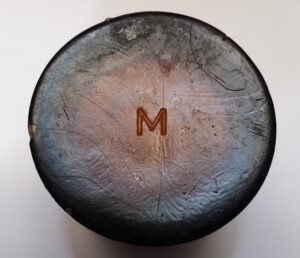
- M (on the bottoms of intricately designed, hand decorated milk glass dresser set items, such as shallow ring trays and glove trays)…………. almost certainly James J. Murray & Company (Murray Flint Glass Works), Philadelphia, PA (c.1891 or earlier – c.1922 or later?). This glass maker, located on the corner of Culvert Street & Trenton Avenue south of Waterloo Street, specialized in lamp globes, shades and other lighting fixture-related glassware as well as novelty items. This company might have expanded to become a distributor of a wider variety of goods for department stores in later years.
- M………………. a large, plain “M” is seen on the bases of some small, clear glass root beer style mugs that were originally sold as candy containers. This “M” may stand for the J.H. Millstein Company, of Jeanette, Pennsylvania, or possibly for Marienville Glass Company, Marienville, PA., producing the glass FOR Millstein.
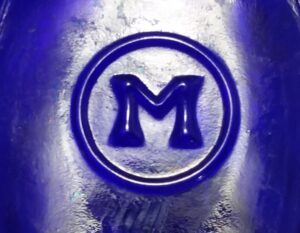
“M in a circle” trademark used by Maryland Glass Corporation, here embossed on the base of a cobalt blue Merrell’s Milk of Magnesia bottle. - M inside a circle (on the bottom of glass containers, especially medicine bottles of many types and sizes, often in cobalt blue glass) – see more information about this mark on this webpage: Maryland Glass Corporation, Baltimore, Maryland (1907-1980) . This “M in a circle” was used by Maryland beginning in about 1921, and is seen, nearly always, only on machine-made bottles and jars. Also, please see next two entries.
- M inside a circle (on the bottom of handmade bottles) ………… currently unidentified glass manufacturer. A rather small number of bottles have been found that could not have been made by Maryland Glass Corporation, as they are mouthblown and date from before Maryland started using their “M in a circle” trademark in 1921. They are American-made, are found in colorless glass, are not machine-made, and would date from the 1880s-1890s – no later than around 1910. Some examples of these bottles include: a “Sunburst” design whiskey flask with a ground screw-top lip; a “Honey Suckle” choke-neck style back bar bottle with swirled design on shoulder; “Taylor & Williams Whiskey, Louisville, KY” cylinder whiskey; “Geo. T. Stagg Co, Frankfort, KY” cylinder; “V. E. Shields & Co, Cincinnati, O” flask; and a prescription-lip clear druggist-style bottle embossed “H. D. Block / 245 E. Jefferson St./ Louisville, KY” (actually a liquor distiller/distributor) on the front. Since most of these bottles appear to be from the KY/OH area, it is most likely that the unidentified glass bottle-making company was located in that general area, and (of course) had a company name beginning with the letter “M”. If anyone has good info on what company this could be, please let us know!
- M inside a circle (on upscale tableware, novelty glass, salt dips, glass shoes, children’s mugs, decorative toothpick holders and many other types of reproduction colored glassware, typically not on utilitarian/commercial containers)………………………….. Mosser Glass Company, Cambridge, Ohio (1971-to date). NOTE: the “M” may or may not have slightly angled vertical strokes so that the letter appears to be an upside-down “W“. Also please see “M” and “M within outline of the state of Ohio” entries, as well as the “M inside a circle” entry concerning Maryland Glass Corporation.
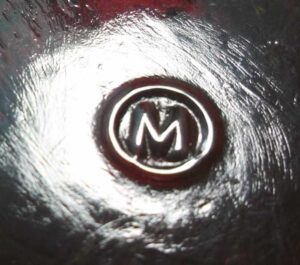
Mosser Glass Company – “M inside a circle” mark on the base of ruby red toothpick holder/votive candleholder. - M inside a G (shown, lower right) …………………… Maryland Glass Corporation, Baltimore, Maryland (1907-1980). This particular mark is confirmed to exist on the base of a cobalt blue rectangular “2 oz” marked bottle, with vertical ribbing on the front; probably an iodine or poison bottle. Also seen on the base of a cobalt “Perfection Ginger Ale, Brooklandwood Springs Company, Baltimore, MD” bottle. (Thanks to Ken Previtali for the information on the ginger ale bottle!) The “G” is very similar in appearance to a horizontally oriented oval. Because of its presence on the Brooklandwood Springs bottle, I consider this to be virtual proof that this particular mark was indeed used by Maryland, although only in rare instances as compared to their “M inside a circle” mark. Although many bottles made by Maryland were unmarked, the great majority of bottles that are marked are found with either the “M in a circle” logo, or a “plain M”.
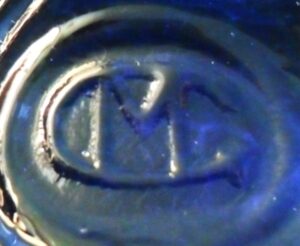
“M inside a G” mark, as it appears on the base of 2-ounce rectangular poison or iodine bottle made by Maryland Glass Corporation - M inside a diamond, seen on druggist bottles and glass eye wash cups……………. John M. Maris Company, wholesalers/jobbers of druggist ware, sundries, pharmacy “furniture”— this firm began in 1842 as Pleasants & Maris, name changed in 1846, business offices in Philadelphia and New York City. Still in business (2015) with offices currently based in Rockaway, New Jersey. John M. Maris Co. sold drugs wholesale until 1872 when they changed the focus somewhat and started selling a large line of glass druggist bottles and related ware (Pharmaceutical Era, Vol. 39, pge. 166, 1908). Apparently most (if not all) of the glass sold by Maris was actually manufactured by unnamed glass bottle companies, in early years almost certainly by Whitall Tatum & Company of Millville, New Jersey who specialized in druggist ware of all types. The “M in a diamond” mark is confirmed on several different glass items including a clear druggist bottle circa 1885; clear and cobalt blue eyewash cups; and a miniature clear glass mouth-blown lamp with a ground lip and metal screw-top wick assembly which was seen on ebay and said to have possibly been used for medical/laboratory purposes. Apothecary weights (tokens) are known with the “M inside a Diamond” logo. Also, confirmed as marked on the bottom of a milk glass cold cream jar, circa 1920s-1940s (but this item may or many not have any connection with Maris)? Also, please see next entry. (Thanks Nona H. for the eyecup, and thanks to George Sturrock for his help in researching this mark!)
- M inside a diamond (on Mason-type zinc caps for fruit jars, and their corresponding milk glass “discs” or inserts)………………..Marion Fruit Jar & Bottle Company, Marion, Indiana – with plants also located at Fairmount, IN; Converse, IN and Coffeyville, KS (1888-1904). “The Marion Jar”, a fruit jar made circa 1890s to 1904, originally came with these lids. The “M” has slightly out-curved “legs” which make the mark appear as the letter “W” when viewed upside down.
ADVERTISEMENT
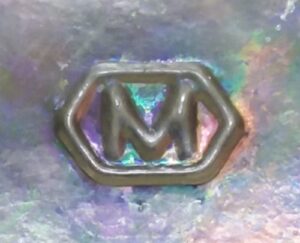
- M in a hexagon…………… Metro Glass Bottle Company, Jersey City, New Jersey. Mark used c.1949 – c.1981. Also with plants at Washington, PA (since 1957); Carteret, NJ (1958) and Dolton, Illinois. Known as the Metro Glass Division of National Dairy Products Corp. after 1956 (Kraftco after 1969). Later known as MetroPak Containers. MetroPak was bought by Ball Corporation in 1980. The Jersey City plant was closed on Nov. 13, 1981, but the other three plants continued in operation.
- M in a keystone……..Metro Glass Bottle Company, Jersey City, New Jersey (Mark used c.1935-1949). See above entry.
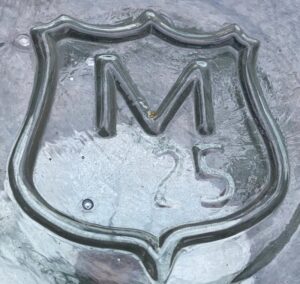
“M inside a shield” on the base of an Arrowhead brand water bottle. The “25” is a date code for 1925. (Photo courtesy of Peter Utas). - M in a shield…………………Monarch Glass Company, Los Angeles, California (1924-c.1926). Seen on the bases of Puritas and Arrowhead brand 5-gallon water bottles, as well as blank slug plate (unbranded) water bottles. Thanks to Peter Utas for this information and for the photo at right.
- M in a shield (shield-like emblem shaped like the state of Ohio – seen on colored tableware and novelty glassware, not commercial bottles)………………… see next entry.
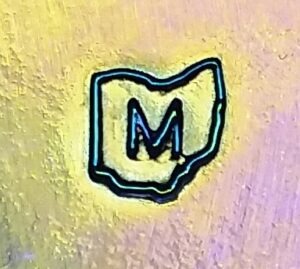
“M inside an outline of the state of Ohio” mark used by Mosser Glass Company of Cambridge, Ohio, as seen on the inside of the base of a blue carnival glass mug. The mark may appear “flipped horizontally” when looking at it from above. - M within outline of the state of Ohio…………… Mosser Glass Company, Cambridge, Ohio (1971-to present). Occasionally seen on colored tableware and upscale novelty glassware. Mosser has produced toothpick holders, salt cellars, mugs, small animal figurines and other “whimsies” as well as a lot of glass that replicates the “look” of Early American Pattern Glass tableware. That glass has been made in new molds, and in many different colors that were not used in the original patterns. Also, see “M in a circle”, “M with a line underneath”, and “M”.

Midland Glass “Stylized M” logo (lower left) on bottom of “Stubby” amber beer bottle made in 1973. - M (abstract representation), shown, consisting of one stroke, a narrow rectangle or horizontal line, positioned over three other narrow rectangles or vertical strokes (at right angles). This logo may have been intended as an abstract M, but also appears something like a capital “E” with a space between the vertical stroke and the three horizontal strokes. Looking at it upside down, the mark might resemble the Roman numeral “3” with an underline…………………….. Midland Glass Company, Inc., Cliffwood, New Jersey; Terre Haute, Indiana, and Shakopee, Minnesota (1968-1984?) This mark is frequently seen on “stubby” non-returnable beer bottles of the 1970s.
- M with a line underneath (Underlined “M”)……………………on a few pressed glass items made by Mosser Glass Company, Cambridge, Ohio (1971 to present). Mosser makes pattern glass tableware, decorative glass and novelties, usually in colorful glass. This mark is seen on the inside bottom of at least one example of the “Robin in a Tree” mugs made by Mosser Glass. Other examples of Mosser glassware may have an “M in a circle”, “plain M” or an “M inside the state of Ohio” mark.
- MACE / U. S. A. ………………………………… Unknown. This appears, along with a “Crescent Moon” logo on the base of a clear pharmacy bottle lettered “Eugene Gosselin / 148 No. Champlain St. / Burlington / VT”. Info on this bottle was reported by Barry Conolly. (See “Crescent Moon” entry).
- M A Co. (inside diamond), as seen on the base of a clear glass shaving mug, possibly circa 1900 – 1930…………….. This mark is unidentified/ unknown.
- MAINE, with number and/or letters & the word “SEAL”, on milk bottles) ………………………………… a number of glass manufacturers made milk bottles with this type of marking, required by state law, for bottles used within the state of Maine. See list at this milk bottle site (archived snapshot): https://web.archive.org/web/20140214150205/http://dairyantiques.com/Milk_Bottle_Marks.html
- Mansfield Glass Works……….Mansfield Glass Works, Lockport, New York (1872-c.1909). See Lockport Glass Works entry.
- MARION (“The Marion Jar”) – phrase embossed on some “Mason’s Patent Nov 30TH 1858” type fruit jars………………………………………………. made by Marion Fruit Jar & Bottle Company (see “M.F.J.& B. CO” on this page).
- MARVEL………………………………Unknown. Reported on base of clear glass pharmaceutical/drugstore bottle. Probably a brand name used by a particular glass manufacturer for their line of prescription bottles (such as “LYRIC” by Illinois Glass).
- MASON’S PATENT NOV 30TH 1858 ………………… Please click here for a general summary on this marking, as seen on the front of many fruit jars – that were actually made over a very long period of time: Mason’s Patent Nov 30TH 1858 Fruit Jars .
- MASS (with number and/or letters & the word “SEAL”, on milk bottles) ………………………………… a large number of glass manufacturers made milk bottles with this type of marking, required by state law, for bottles used/distributed within the state of Massachusetts. See this site for a list of similar marks: https://web.archive.org/web/20140214150205/http://dairyantiques.com/Milk_Bottle_Marks.html
- MASS GLASS CO. …………….Massachusetts Glass Company, Somerville, Massachusetts (c.1867-1871?) . This manufacturer is believed to have produced unmarked glass insulators, apparently none of which have been yet positively identified (See my page on Insulator Manufacturers). This rare mark, which is assumed to be linked to that same company, has been reported observed on the base of a very, very small number of bottles.
- Maul, Hebrew & Co………… Maul, Hebrew & Company, Bridgeton, New Jersey (1855-c.1857). This mark is seen on the base of an olive green cylinder whiskey bottle with applied lip.
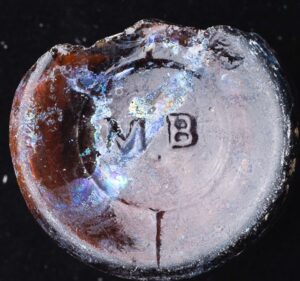
M.B. on amber beer bottle base shard (photo courtesy of Ansen Seale) - M. B. (as seen on the base of export-style beer bottles)……………………………………..unidentified with certainty, but possibly a mark used by Massillon Glass Works (Reed & Company) of Massillon, Ohio (1881-1904). Four similar mark variants have been recorded, including M A, M B, M C, and M D. (Periods may or may not be discernible). For more information on these and other possibly related marks, please see this pdf file article by Bill Lockhart: https://sha.org/bottle/pdffiles/BandE22-2.pdf
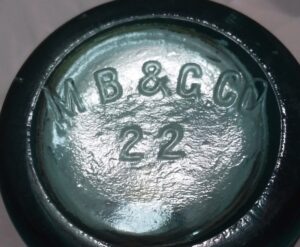
M.B.&.G.CO. initials on base of beer bottle – Massillon Bottle & Glass Company, Massillon, Ohio (22 is a mold number). - M. B. & G.CO…………….. Massillon Bottle & Glass Company, Massillon, Ohio (1900-1904). Photo above shows the mark on the bottom of a handblown, tooled lip quart size beer bottle in aqua. Also see “R & CO”.
- M.B.W………………Millville Bottle Works, Millville, New Jersey (1903-1926). Bought by T. C. Wheaton Company in 1926. MBW made chemical, druggist and laboratory bottles, glass tubing, funnels, etc. Exactly when the “M B W” was discontinued in actual practice is unclear, as bottle molds in use at the time of the buyout in 1926 might have continued to carry that mark for just a little while after 1926, before eventually being retooled. See T.C.W.& CO.
- McC………………..William McCully and Company, Pittsburgh, Pennsylvania (1841-c.1909)
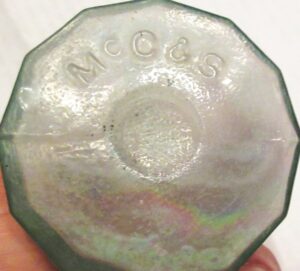
McC&S mark on base of umbrella ink bottle. (Photo courtesy Jack Klotz). - McC & CO……………William McCully and Company, Pittsburgh, Pennsylvania (1841-c.1909)
- McC & S……………………..Unidentified with certainty. These initials appear on the base of an American-made aqua 12-sided “umbrella ink” bottle (shown above) which appears to date from the 1860s into the early 1870s. The base is a “key mold” type without a pontil mark. This is only one of two reports of this bottle (and mark) that I am aware of. One possibility, although tenuous: To my knowledge there is only one brief instance of the firm name “Wm McCully & Son” – evidently from the 1850-1852 timeline as seems to be implied on page 187 of “Allegheny County’s Hundred Years” (1888) by George Henry Thurston. However, the bottle on which this mark appears seems to post-date the early 1850s, so at this time I can’t say if that would be the correct attribution?! If anyone else has seen this mark on any bottles, please contact me!
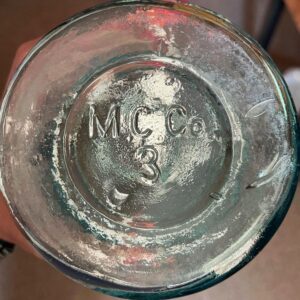
- M C CO (on base of wax sealer fruit jars)………… Uncertain meaning. This might be a case in which the “C” was intended to be a “G”. However there are jars known with mold numbers “3” as well as “4” and in both quart and half-gallon sizes. This would seem to indicate the “C” is intentional and deliberate and not meant to be a “G”. If the letter was supposed to be a “G” the jars would presumably be products of the Mississippi Glass Company of St. Louis, Missouri. Alice Creswick (The Fruit Jar Works) wrote that W. McCully & Company of Pittsburgh might be a possibility. Researcher Dick Roller (The Standard Fruit Jar Reference) wrote “maker unknown”. Please see the “M. G. CO.” page.

- McCracken ………………….. Name neatly embossed (vertically) on an antique cylindrical frosted glass (matte finish) vase or container of uncertain purpose and origin. No other markings. This was found in a dumpsite in the Louisville, Kentucky area, with items mostly dating from before 1900. No information found. Possibly a funerary / cemetery florist vase?
- M.C.G.CO……………..Unidentified. This mark appears on the base of several clear, handmade druggist/prescription bottles. Possibly from an unidentified glass company in one of the Eastern states, perhaps New Jersey?
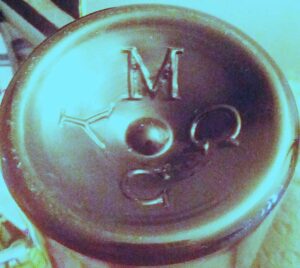
“M G C Y” or “M C G Y” (with smaller, faint IA between G and C) on base of black glass bottle. Unknown British maker. (Photo courtesy of Natasha Moletta) - MCGY or MGCY (M C G Y / M G C Y) (with smaller faint letters I A)……………………..Unknown. This mark appears on the base of a black glass ale or beer bottle probably from Great Britain, and likely dating from sometime in the 1860s-1890s. Similar to the dark olive green “black glass” ale bottles marked “C. W. & CO.”. The order of the letters is assumed to be as stated, but it is possible the first letter may not be the “M”. Also, it is not absolutely clear if the letters “C” and “G” are correctly identified, as they appear very similar, so the actual abbreviation could be “M G G Y”, “M C G Y” or “M G C Y”. If anyone in the UK knows the identity of this early glass company, please advise!
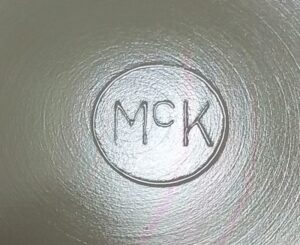
“McK in circle” mark, as it appears on the base of an ivory (custard glass) child’s mug lettered “Tom & Jerry” on the front. This probably dates from the 1930s. - McK in a circle (above)………….. McKee Glass Company, Jeannette, Pennsylvania (1888-1951). Seen on various items such as black glass salt shakers and other opaque glass tableware, this mark was perhaps used mostly in the 1930s and ’40s. McKee became a subsidiary of Thatcher Glass Manufacturing Company in 1951, and eventually the factory was purchased by Jeannette Glass Company in 1961. For some more information on McKee, click here: McKee Glass Company.
- McKee & Co…………..see McKee Glass Company page.
- McK. G. Co. …………. McKee Glass Company, Jeannette, Pennsylvania. Seen on the base of syrup dispenser, circa 1951. See McKee Glass Company page.
- McL………………….McLaughlin Glass Company, Vernon, California (1920-1935). Especially well known by glass collectors for their electrical insulators, McLaughlin also produced a wide variety of bottles and other glassware. Most McLaughlin products are found in the Western states of the US. For more information see this page: McLaughlin Glass Company. Note: Some water bottles (and possibly other types of bottles) marked with “McL” on the base also date somewhat later, from the 1940s and 1950s, when William McLaughlin operated other, smaller factories in Vernon and Gardena, California.
- McLaughlin (on glass insulators)……………….McLaughlin Glass Company, Vernon, California (1920-1935)
- M C W …………….Mallinckrodt Chemical Works, St. Louis, Missouri (1867-to date). I believe most, if not all, of the bottles found with this mark are hand-blown and date from approximately the 1880-1920 period. The actual glass factory where these bottles were made is unknown, but Illinois Glass Company, Alton, IL, would be a likely source.
- Mechanic Glass Works, Philada……………..Mechanic Glass Works, Philadelphia, Pennsylvania. Exact dates of operation currently uncertain, but a very scarce flask which bears this inscription appears to date from sometime in the 1845-1865 period.
- MEG (M E G)………………………. Middle East Glass Manufacturing Company, Nasr City, Cairo, Egypt (1979 to present). Initials seen on the heel of a packer jar that contained a brand of strawberry preserves. MEG has three glass manufacturing locations – at Nasr City, Sadat City, and Mostorod, Egypt.
- M. F. J. CO. ……………probably variation of next entry, seen on base of wax sealer jars.
- M. F. J. and B. CO……… Marion Fruit Jar & Bottle Company, Marion, Indiana (1888-1904), Fairmount & Converse, Indiana (1894-1904). Plants bought out by Ball Bros. in 1904.
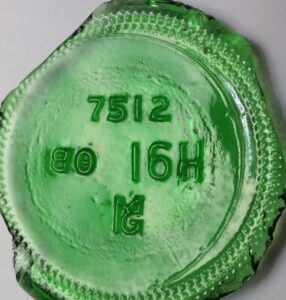
- MG, M/G, M over a G (as shown above)…………………Madera Glass Company, Madera, California (1970-c. 2000?). Found on wine bottles. This glass factory is still operating (2024) and is now part of Ardagh Group (since 2014). The plant was acquired by Saint-Gobain Containers, later Verallia, before becoming part of Ardagh Group. If anyone knows what year this MG mark was actually discontinued and when the later marks were phased in at this factory, please contact me!
- MG (letters connected, as shown here)………………….. Maywood Glass Company, Compton, California (1930-1959). For more information, please see the Maywood Glass Company page.
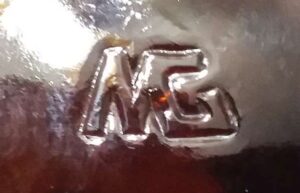
- M.G.CO……………..See this webpage on MGCO mark.
- M.G.M.CO (monogram)…..prob. Minneapolis Glass Mnfg. Company, Minneapolis, Minnesota (c.1886).

MG(or GM) monogram on base of dark amethyst “MASON’s PATENT NOV 30TH 1858” fruit jar. (Photo courtesy of Abby Chovanec) - MG (or GM, monogram, letters M & G entwined/superimposed over each other, shown above). Unknown meaning. This mark appears on the base of a dark amethyst/purple “Mason’s Patent Nov 30TH 1858”-type fruit jar, which appears to be a recently-made reproduction jar, probably manufactured in China or India.
- M G C Y or M G G Y…………………….. see “M C G Y” entry, above on this page.
- M. & G. M. / N. Y. ………………. (on base of mouthblown, cylindrical, aqua colored, vertically ribbed peppersauce bottle, pontil scarred, 21 ribs, possibly dating from the 1850s-1860s era). Unknown meaning. The embossed lettering appears on the resting surface of the bottle. The initials might stand for an obscure glass factory, or perhaps a food products distributor.
- M. G. W. …………..Massillon Glass Works, Massillon, Ohio (1881-1904). This mark has long been a mystery, with very little concrete evidence available pointing to any specific glassmaker. For a long time, I had posted Middletown Glass Works of Middletown, New York (1887-1891) as a possible user of the mark. However, recently it has come to my attention that the Massillon Glass Works, a factory which was later more commonly known under the firm name (operating company name) of Reed & Company,(see “R & Co” mark) is virtually certain to be the true source of bottles which carry this mark. Virtually all MGW bottles which also carry brewery or soda bottling firm names (lettered on the face of the bottle) are from cities located in Ohio (plus a bare handful from southern Michigan). This is very strong evidence for a glass manufacturer from that general area. In-depth study by archaeologist/author/researcher Bill Lockhart, and, in addition, information submitted by Rob Riese, a Massillon-area bottle collector (concerning MGW-marked beer bottles found barely a few hundred feet away from the original site of the Massillon Glass Works), virtually clinch this identification once and for all. Most of the M G W bottles are export beers, of the same general type and appearance of the R&CO beers made by Reed & Company. It is very possible that the MGW mark was used for the first few years of operation, and later the R&CO mark was phased in. Furthermore, it is possible both marks were used simultaneously for some period of time. Thanks to Bill Lockhart and Rob Riese for this update! Also please see “M” and “M B” marks.
- Michigan Mason (on fruit jars)……………….. Michigan Glass Company, Saginaw, Michigan (1911-1916).
ADVERTISEMENT
- Milford Glass Works……………….. Milford Glass Works, Milford, New Jersey (1838-c.1860). This factory operated under several firm names, beginning under the name “Pendleton Glass Works” in 1838 (according to Adeline Pepper in her book on NJ glass factories). Some “Louis Kossuth / S. Huffsey” historical calabash flasks are thought to have been made here in the early or mid-1850s. Several scarce ale bottles with the embossing “MILFORD GLASS WORKS” (in an arch) are known and probably date from the 1850s. There were two different small towns known as Milford (or Millford) in the state of New Jersey during that time period. The one in question is now known as Kresson and is located in Camden County. The other town (evidently NOT connected with this glassworks) is still called Milford and is located in Hunterdon County.
- MILLVILLE BOTTLE WORKS 1888 …………. lettering on reproduction (fantasy) bottle manufactured by T.C. Wheaton Company circa 1970s. (Please see discussion in “Comments” section below, starting with query posted by Robin on 8/1/2017.)
- MINN (in a triangle, along with a 1 or 2-digit number, on milk bottles) ………………………………… a number of glass manufacturers made milk bottles with this type of marking (required, for a time, by state law for bottles to be used within the state of Minnesota). Seen on the heel or the shoulder. See this site (archived, but no longer live) for more information: https://web.archive.org/web/20140214150205/http://dairyantiques.com/Milk_Bottle_Marks.html
- Missouri Glass Co. / St. Louis, Mo. (embossed lettering on the face of wax sealer fruit jar)……………… this particular jar was evidently actually made by Newark Star Glass Works, Newark, Ohio (Shields, King & Company, proprietors at the time, FOR Missouri Glass Company). Please see this page: M G CO. marks on bottles and jars.
- M. J. CO. …………….Unknown (Seen on base of wax sealer fruit jar).
- M’Kee……………… S. McKee & Company Pittsburgh, Pennsylvania. Click here for more info: McKee Glass Company.
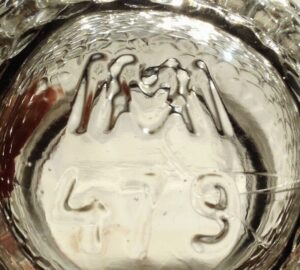
“MM” monogram on base of jam jar. “479” mold or style number is placed below the logo. (Photo courtesy of Kath) - MM, interconnected (letters intertwined/overlapping)…………….. unidentified emblem / monogram as seen on base of clear glass jam / preserve jar made in the shape of a strawberry, found in the UK, possibly from the very early 20th century. The mark looks similar to one pictured on page 365 of Bottle Makers and their Marks by Julian Toulouse (1971) which he noted as “meaning unknown”.
- Mo. G. Co…………….Missouri Glass Company, St. Louis, Missouri (c.1859-1911). Seen on face of rare wax sealer fruit jar, probably dating from the 1860s or ’70s. This particular jar may or may not have actually been made by Missouri Glass Co – possibly made for them by a Pittsburgh, PA glassmaker. Please See M.G.CO.
- Moderne Oval (seen on the base of glass druggist bottles)…………………… Foster-Forbes Glass Company, Marion, Indiana (1929-c. 2000). The marking is actually listed as “MODERRE OVAL” on several trademark info websites, although the cursive lettering on actual bottles certainly looks like it was intended to be “MODERNE“!! The trademark was registered on October 13, 1959, with first use claimed to have been on July, 1, 1930. The trademark was “Cancelled” in 2000. The bottles with this mark look to date mostly from the 1960s and 1970s(?)
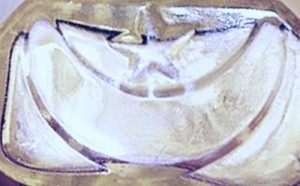
Moon & Star mark on base of druggist bottle (Photo from “Madman”, member of antique-bottles.net) - Moon & Star logo, on base of clear druggist bottles (shown)……….. Manufacturer not identified with absolute certainty, but this is probably another mark used by Crescent Bottle Company, McDonald, Pennsylvania. The moon and star is actually “Debossed” (sunken) into the base of the bottle. Please see my entry under “Crescent Moon logo” on page two.
- Moon logo (without star)…….see “Crescent Moon” entry.
- Mountain Mason………..Intermountain Glass Company, Midvale, Utah (c.1930s). Brand name found embossed on fruit jars. See “IGCO (monogram) in brackets” entry.
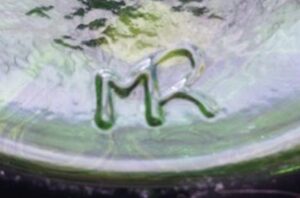
“MR connected” mark on base of olive green oil lamp, possibly Mexican. (Photo courtesy of Kath) - MR (letters connected)…………………… as seen on the base of a dark olive green oil lamp. The time period when this oil lamp was made is unknown, but perhaps mid- to late 20th century? Two examples have been seen in olive green, as well as one in clear glass. Both olive green examples surfaced in Great Britain (UK). One of the olive green examples has the green shading into a rich cobalt or “Bristol” blue color toward the base. The design of the lamp consists of large embossed ovals or “eggs” covering most of the surface of the glass. I was told in a Facebook lamp collecting discussion group that this lamp may be a product of Mexico. I thought it might be European or Asian? If you have info on this mark, help with accurate identification is requested!
- M/T (Monogram)………………See T/M mark.
- M T C inside a triangle…………………Thatcher Manufacturing Company.
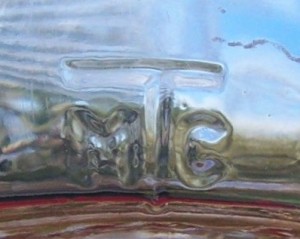
“M T C” mark on heel of milk bottle. (Photo courtesy of ebay seller Cawhite1946) - M T C………………Thatcher Glass Manufacturing Company, Kane, PA; Wharton, New Jersey and several other plant locations in later years (c.1904-1985). This particular variation is seen in the form of a large T with smaller “m” and “c” sheltered underneath the “roof” of the T, in rather plain “block” style lettering, as shown in photo. (There is another, more common variation which was used later, a large T with a smaller, angular M and C underneath, which I show under the “TMC” entry on page 5, and on the webpage about Thatcher Glass). For more information on this and other marks used by Thatcher, please see the Thatcher Glass page here.
- Mt.L. (see pic shown below) ……………………. unidentified/unknown meaning. Mark seen on base of amber machine-made beer bottle with no markings on sides, but with unusual “hobbleskirt” type profile, that appears to be from the 1910-1930 period. This mark may stand for either a glass company OR a brewer or bottling company, perhaps meaning “Mount L______” ?

MT.L. mark on base of amber beer or soda bottle. (Photo courtesy of Seth Miller) - Mutual Glass Co, Pitts………………..Mutual Glass Company, Pittsburgh, Pennsylvania (c.1869-c.1888). Name embossed on base of a wax sealer fruit jar. This rather obscure concern made tableware as well as oil lamps, chimneys, chandeliers, fruit jars, bottles and flasks. Also known as Gallinger and Company. Date information courtesy of Jay W. Hawkins’ Glasshouses and Glass Manufacturers of the Pittsburgh Region 1795-1910 (2009) with more detailed info in that reference book.
- M and V (entwined) within a circle……………Vidriera Monterrey, Monterrey, Mexico (1909-to date). I am not sure of the dates of use for this mark, which appears on some glass telephone line insulators (such as CD 106.4) that were made and used in Mexico. It has also been seen on some hobbleskirt Coke bottles, and when faintly embossed, the mark may look something like a “heart inside a circle”. Another mark which is virtually identical in appearance is found on several types of glass insulators made in France. (See next entry). Also, see the “V” mark, and the “V over M inside a triangle” marks on page five.
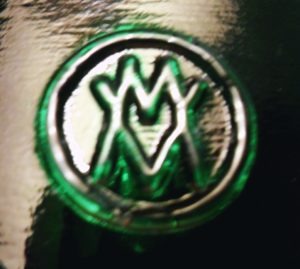
MV (VM) logo on CD 642 “Gingerbread Man” style insulator made by Verreries de Masnieres - M and V (entwined) within a circle…………..Verreries de Masnieres (Masnieres Glassworks), Masnieres, France. This mark is seen on the skirt of French-made glass electrical insulators, such as the CD 642 style “Gingerbread Man”, typically seen in shades of dark olive and emerald green glass. There is apparently no connection between this factory and the Mexican glass factory (see above) which also made insulators, although both marks are nearly identical in appearance. The Masnieres glassworks dates back to 1818 with various name/firm changes over the years. The range of dates this mark was used is uncertain, but might be from the 1920s-1950s? If you have better info on the years this was used, please contact me!
ADVERTISEMENT
- 17N (or other number between 16 and 30)………………… on the heel or base of soda and beer bottles, usually American Bottle Company, at their glass plant located in Newark, Ohio. On some bottles the letter may precede the number. Evidence indicates the date codes (16, for instance, is believed to indicate 1916) may have been used earlier, as well as later —- perhaps from ABCO’s beginning in 1905, all the way up to 1929, at least on a few bottles. I have received a report that some bottles carried apparent date codes as late as 1933, several years after the former A.B.CO. plants had become part of Owens-Illinois Glass Company. Also see “16S”, “AB”, and “A.B.CO” entries. For more background information on American Bottle Company and their number/letter codes, please check out this webpage article by archeologist Bill Lockhart (and other researchers), especially the chart shown on page 347 of the document. This is a .PDF file : https://sha.org/bottle/pdffiles/AmericanBottleCo.pdf
- N (on the bottoms of handblown, applied-lip dark olive green or olive amber “black glass” beverage bottles) ………………………unidentified with certainty, but possibly a shortened mark of Nuttall & Company, St. Helens, Lancashire, Great Britain. (See “N & Co”) . These bottles were exported from England in large numbers to the US. They might have contained mineral water, ale, beer or wine. Some are marked with a “K” or a “B” on the bottom – perhaps other letters are known. I presume most of them date in the 1870s-1910s era.
- N………………………………….Obear-Nester Glass Company, East St. Louis, Illinois (1894-1978). Although this “N” is normally seen inside a square (see entry below on this page), some bottles are seen with just a plain ‘N’, such as an amber “Winstead’s Lax-Fos” bottle. The bottle in question is machine-made, and dates from sometime in the 1910s -1930s. See “N in a square” page.
- N in a circle or oval…………Obear-Nester Glass Company, East St. Louis, Illinois (1894-1978). Mark is believed to have been used during the early years, on handblown ware, up to about 1915. See “N in a square” page.

IN or NI monogram on base of food bottle (Photo courtesy of Elaine Rex) - N I (or possibly I N), letters entwined (monogram) as shown at right…………… Unidentified. This mark appears on the bottom of a clear glass narrow, cylindrical food bottle of the type often used for products such as olives and capers. This also bears a “48” to the right of the monogram which is presumed to be a date code for 1948.
- N (underlined, inside a circle)…………………..Northwood Glass Company, Wheeling, West Virginia (1902-1925). Harry Northwood opened his first glass works at Martin’s Ferry, Ohio in 1887, and also operated factories in Ellwood, PA and Indiana, PA before he started his last and most famous factory at Wheeling in 1902. This mark is seen on carnival glass and other decorative glassware made at the Wheeling factory. All glassware made there was not marked, although a good percentage of it was. A similar mark was also used for awhile by L. G. Wright Glass Company on some of their glass, prompting a lawsuit in which they were forced to stop using the mark.

“N inside a vertical diamond” used by National Glass Works, as seen on base of kitchen canister or spice jar. (Photo courtesy of Liz Clarke) - N in a diamond……………National Glass Works (York), Limited, Fishergate, York, Yorkshire, United Kingdom (c.1930-1967). Known as York Flint Glass Company, founded circa 1837. Incorporated as National Glass Works in 1930. National merged with Redfearn Glass Works in 1967. York factory closed c. 1984?? Exact stretch of years of usage of the N-Diamond mark is unclear, but it was surely in use at least during the 1950s and 1960s. Additional info on dates of usage of the mark is sought from readers!
- N in a keystone (shown below) ………………………… Newborn Glass Company, Royersford, Pennsylvania (1887-1925). This glassworks began as Royersford Stock Glass Company in 1885. In 1887 the glassworks was purchased by Jonathan D. Newborn along with four of his sons and Samuel P. Van Pelt, and around that time the firm name (business name) became Newborn, Sons & Company. The company underwent a reorganization in about 1896, afterward trading as “W. H. Newborn & Co.”. In 1920 the firm name was changed again slightly to Newborn Glass Co., Inc. The factory itself was usually referred to as “Royersford Glass Company” or “Royersford Glass Works” in trade magazines although locals called it the Newborn Glass Works or Newborn Glass Company. The year of introduction of the “N in a keystone” mark is uncertain, but possibly it was introduced around 1920 and used up to the plant closing in 1925. The mark is very scarce and has been seen on only a very few types of bottles. It seems likely that most bottle production from this factory was not marked with any glassmaker identification.
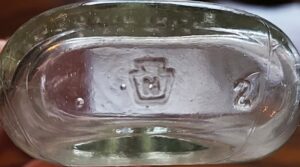
“N in a keystone” mark – Newborn Glass Company, Royersford, PA., as seen on base of oval “Edison Battery Oil” bottle (Photo courtesy beckyreedde@Gmail.com) - N in an oblong (or vertical rectangle) …………Obear-Nester Glass Company, East St. Louis, Illinois (1894-1978). This mark was supposedly used concurrently with “N in a circle” and “N in an oval”, on handblown ware from c. 1894 or 1895, up to about 1915. After 1915, on machine-made ware, the “N in a square” was instituted as their standard mark. On some bottles it’s hard to say if the “box” is better described as a “rectangle” or a “square”, as the whim of the mold engraver resulted in some variations in exact appearance – so any particular mark could lean in one direction or the other. See “N in a square” page.
- N in a rectangle (see above entry, and “N in a square”).
- N in a shield………… Nelson Glass Company, Muncie, Indiana (1892-1896). In “400 Trademarks on Glass” by Peterson (1968) on page 47, he lists this mark as used circa 1893 on fruit jars (apparently referring to an illustration in a trade journal advertisement). I know of no instance where this mark has actually been seen or documented, but perhaps time will tell.
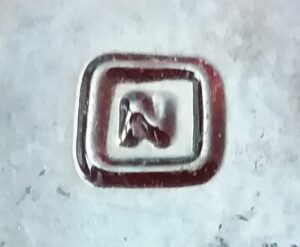
“N in a square” trademark used by Obear Nester Glass Company, East St. Louis, Illinois – on base of amber bottle. - N in a square or “box” (shown above)…………..Obear-Nester Glass Company, East St. Louis, Illinois (1894-1978). Obear-Nester made huge quantities of bottles of many types for several decades, much of it in amber-colored glass. They produced some of the amber Orange Crush soda bottles, Purex bleach bottles and many others. Some sources imply that this “Box N” mark (and/or an “N in a rectangle) was first used as early as 1895, but Toulouse states the “N inside a square” was first used on machine-made bottles circa 1915. For more info, see “N in a square” page.
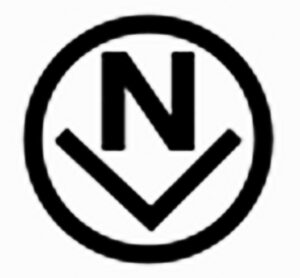
- N over a somewhat “flattened” V, inside a circle, shown (upside down, this mark resembles an N under a “roof”) ………………. Previously unidentified, Lou Bisiecki has kindly informed me by email that this mark is used by Vetri Speciali S.p.A., Italy, at its Pergine Valsugana glass container plant.
- N next to (or within) a star………see Newark Star Glass Works, Newark, Ohio (1873-1904).
- Nathan & Wight / Patented …………………… as seen on base of clear bottle/shaker with eight fluted sides and ground lip. Nathan & Wight (Henry C. Nathan and George R. Wight) was a manufacturer and seller of mucilage (glue), based in New York City, and, judging from advertisements in period trade magazines and newspapers, operated in the 1880s and early 1890s. This glue bottle with an “octagon” base can easily pass as a salt shaker, and could certainly serve as one with a fitting perforated lid. The glass manufacturer that made these containers is unidentified.
- N.B.B.G.CO…………….North Baltimore Bottle Glass Company, North Baltimore, Ohio (1888-1895), Albany, Indiana (1895-1900); and finally the factory operation was moved to Terre Haute, Indiana (1900-1926). Producer of a very large number of soda, mineral water and beer bottles made for many companies, especially throughout the Midwest. The initials are usually found on the heel of their bottles, often in small, lightly embossed, inconspicuous lettering. The great majority of bottles found with the NBBGCO mark would likely date after their move to Indiana.
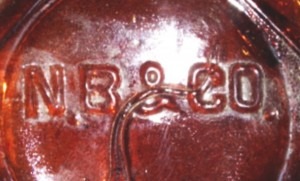
N B & CO amber bottle base shard (Photo courtesy of Jon McCormack) - N B & CO. ………………..Nelson Baker & Company, Detroit, Michigan (1890-1950). Nelson Baker was a pharmaceutical / drug manufacturing company. N B & CO combined with Penslar Chemical Company in 1950. Mark (as shown) appears on base shard of a square amber medicine bottle, possibly circa 1900-1920, photo submitted by Jon McCormack. Thanks Jon!
- NC within a slightly flattened triangle (shown below)……………………. Noelle & von Campe Glashütte (Glassworks), Boffzen, Lower Saxony, Germany (Deutschland)………… (1866-to date). I saw this mark on the base of an 8-ounce clear packer jar (containing instant coffee) in October, 2012, and a packer jar (containing raspberry fruit spread from Poland) in March of 2019, both imported to the United States. I don’t know when this mark was introduced or if it has been in use for a long time. The letters inside the triangle may appear somewhat indistinct, smeared or “muddy” and might be misinterpreted as MC, MG, NG, etc.
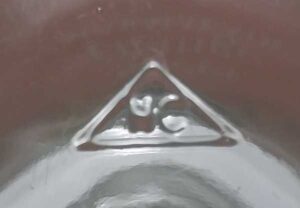
- N & CO………….Nuttall & Company, St. Helens, Lancashire, England, Great Britain (United Kingdom). Nuttall made many types of bottles that were imported into the United States. This mark dates before 1913, when Nuttall merged with several other plants to form United Glass.
- N.C.L.CO……………Nail City Lantern Company, Wheeling, West Virginia (1877-1897). This firm was re-organized as Wheeling Stamping Company in 1897.
- N.E.G.M.CO. (on glass insulators)…………New England Glass Manufacturing Company, Boston, Massachusetts (1898-c.1900)
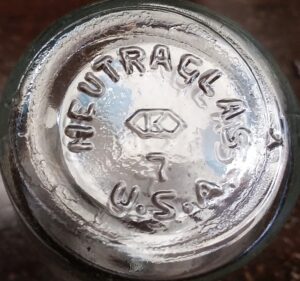
Neutraglas embossed mark on base of small clear glass vial made by Kimble Glass Company. - Neutraglas……………………..Kimble Glass Company, Vineland, New Jersey (1905-to date). This trademark was used by Kimble beginning in 1941, according to trademark information on the Justia website. The trademark is listed as “cancelled” as of 2003, although as far as actual use it may not have been embossed on bottles for many years before that time. (Bill Lockhart wrote that it was probably discontinued around 1955, being supplanted by the trademark “KIMAX”). “Neutraglas” was the name used for their borosilicate glass for scientific, pharmaceutical & industrial applications. It appears on the base of bottles and may be accompanied by the “K in a hexagon” mark used by Kimble (see “K in a hexagon”). Company later known as Kimble/Kontes, and recently (2016) Kimble became part of DWK Life Sciences based in Baden-Wurttemberg, Germany.
- New Albany Glass Works (in circle on base)………….New Albany Glass Works, New Albany, Indiana (1867- c.1872). There is also an ale bottle known with the embossing error “New Albany Glas Works” on the bottom. For more information see this webpage on New Albany Glass Works.
- Newburgh Glass Co……………Newburgh Glass Company, Newburgh (New Windsor), New York (c.1867- c.1872). Also known as the “New Windsor Glass Works” in at least one source (The Telegrapher, trade newspaper, 1867). Embossing confirmed on the base of a very scarce ale bottle. Newburgh also manufactured telegraph insulators, including at least some, if not many, of the insulators marketed by L.G. Tillotson in the late 1860s.
- New Eng. Glass Bottle Co. ………….New England Glass Bottle Company, Cambridge, Massachusetts (1827-1845) . Embossing is arranged in a circular formation along the outer base rim of a “blackglass” (very dark olive green or olive amber) ale, porter or wine bottle. (This firm is not to be confused with the New England Glass Company, also of Cambridge). This mark was suggested to be, by author & glass historian/researcher Helen McKearin, the probable earliest glassworks identification mark known on the base of an American-made bottle, possibly dating from the 1830s. However, no one really knows what year the mark was first used. I believe that another mark (but from the Pittsburgh region) might actually be a contender for “1st place”! See “W. I. & P” entry.
ADVERTISEMENT
- New Granite Glass Works, Stoddard, N.H. …………………. New Granite Glass Works, Stoddard, New Hampshire (c.1861-1871). Full name and location appears on the face of a type of flask with a flag design on the reverse. This glassworks evidently made a good variety of bottles and flasks of various types, but the vast majority of their production was not marked – excepting a few flasks. (See Granite Glass Co.) For more info on Stoddard Glass, see http://www.peachridgeglass.com/2012/01/staddard-glass-updated-information-from-michael-george/
- New London Glass Works…………New London Glass Works, New London, Connecticut (1856-c.1859). Factory name seen embossed on historical flasks. This reportedly became known as “Union Glass Works” about 1859, and was probably the same factory known as “Thames Glass Works” in the 1865-1866 period.

N joined with upside-down L and raised dot or small “o”, made by Nadir Figueiredo S.A. , Suzano, São Paulo, Brazil, South America. - NF. (N joined with upside-down L and raised dot or small “o”, see picture of mark as shown)………………………… Nadir Figueiredo S.A. , Suzano, São Paulo, Brazil, South America. Producer of glass tableware, including tumblers and other items. Illustration is showing the mark as seen on the base of an avocado green glass tumbler or “Rocks” style bar glass. Their website is here: https://www.nadir.com.br/
- N. G. Co. …………………… Northern Glass Company, Milwaukee, Wisconsin (1892-1893). This mark is very uncommon, but has been confirmed to exist by author/researcher Roger Peters.
- N. G. Co. MILW. ………. see above entry.
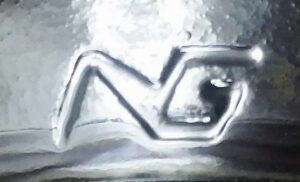
“NG” monogram – National Company for Glass and Crystal, Sharkia, Egypt. - NG (connected, in a monogram)…………………….The National Company for Glass & Crystal, S.A.E., Sharkia, Egypt (1984 to present). This mark (shown above) as it appears on the heel of a clear glass packer jar exported to the US.
- N G W………………Northern Glass Works, Milwaukee, Wisconsin (c. 1896-1900). Continuation of above factory. Mark is uncommon, but does exist. W.F.& S. mark (William Franzen & Son) might have been the actual mark used on much of the product from this factory during the 1896-1900 period.
- NT (as seen embossed lightly on center of base on light aqua beverage (sake?) bottle found washed up along the Oregon coast -this also bears a “67”, probably a date code for 1967)………………. Toulouse (Bottle Makers and their Marks, 1971) lists this mark as being used by Nippon Taisanbin Co., Ltd. in Ogaki City, Japan. No info on entire date range.
- Nuart (Nu-art)……………Imperial Glass Company, Bellaire, Ohio (1902-1984). For a website illustrating some of the marks used by Imperial, check out his page: https://glassencyclopedia.com/Imperialglass.html
- NUCUT (Nu-cut)…………….Imperial Glass Company, Bellaire, OH. Mark used circa 1911-1932, on a small percentage of their pressed glassware. (Note: all glass with the “Nucut” mark, and certain similar marks used by other companies including “Near Cut” or “Pres Cut” are not actually cut glass, they are properly termed “pressed glass”. Pressed glass tableware was made by forcing molten glass under pressure, by either hand or machine methods, into an iron or steel mold). Also, see link in above entry.
- Numbers (numerals, digits) on the bottom of bottles…………….. many bottles and jars have only numbers marked on the base. For more background information, please check out this webpage: Numbers on the bottoms of glass Bottles and Jars.
- NW……………………………… Northwestern Glass Company, Seattle, Washington (1931-c. 1987). The letters in this mark may or may not be connected. In some cases an “NW connected” is placed inside an oval. For more information, check out this webpage from Bill Lockhart: https://sha.org/bottle/pdffiles/NorthwesternGlass.pdf
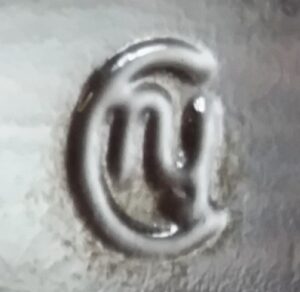
“NY inside a C” mark: Central New York Bottle Company, Auburn, New York - N.W.G.CO. ……………………. (confirmed on base of clear “shoofly” or coffin flask) …………….. North Wheeling Glass Company, Wheeling, West Virginia (1878-1899) and Wellsburg, West Virginia (1899-1900 / 1904-1922). This flask would probably date from the 1880s or early 1890s. The “N” is embossed backwards. Evidently this glassworks did not mark the great majority of their bottles. More info on North Wheeling can be found in this article by Bill Lockhart and the Bottle Research Group: Other N Marks
- NY inside a C…………………..Central New York Bottle Company, Auburn, NY (1978-1994). Made Miller brand beer bottles. From information submitted by John Kuzma, this factory was sold by Miller to Owens-Illinois Inc. in 1994, to become their plant #35, which was still in operation as of 2016.
- N.Y.Q.& C.W.Ld…………New York Quinine & Chemical Works, Limited, Brooklyn, NY. A subsidiary of McKesson & Robbins, a drug manufacturing firm first organized in 1833. I do not know the exact year that NYQ&CW was formed, but bottles bearing these initials on the base are mouth-blown and appear to date from the 1890-1920 period. The glass factory(s) which produced the bottles are unknown.

O inside a diamond- On “H.E. Bills Magic Relief, Bay City, MI” bottle (Photo courtesy of Taylor McBurney) - O inside a diamond (shown). Unknown maker. This appears on a handmade older American bottle marked “H. E. Bills Magic Relief”, possibly circa 1890-1920.
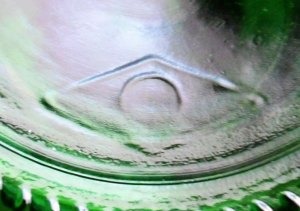
O inside Diamond – Qinhuangdao Fangyuan Glass Company - O inside a diamond (rhombus) ………………. shown here, as seen on base of emerald green mineral water bottle, made circa 2013………………Qinhuangdao Fangyuan Glass Company, Limited, Duzhang, Funing County, Hebei Province, People’s Republic of China (2001-to date). This mark might be confused with a somewhat similar logo once used by Owens-Illinois, Inc. primarily in the 1930s-1950s. However, on this modern Chinese mark, the “O” (circle) is entirely inside the diamond, not entwined or superimposed as was Owens-Illinois’ mark. Qinhuangdao Fang Yuan Glass Company’s official trademark/logo also includes two Chinese characters (Fang Yuan) placed within the circle, but these may not appear on actual bottles. The rhombus shape may appear somewhat “flattened” horizontally (as in pic) or with all sides with 90 degree angles (i.e. an ordinary square balanced on one point).

“O inside a keystone” on the base of a druggist bottle. (Photo from unidentified ebay seller – listing indexed in Worthopedia) - O in a keystone……………….Oil City Glass Bottle Company, Oil City, Pennsylvania (1930-1952). Also, see the “Oil Derrick logo” entry farther down on this page, which was the mark used by their successor, the Oil City Glass Company (1952-1984).
- O in a square……….Owens Bottle Company, Toledo Ohio (1911-1929), also Fairmont, WV; Clarksburg, WV, Charleston, WV and other plant locations. Also called the “Box O”. See the Owens Bottle Company page.
- O inside a triangle (shown) ………………….Unknown meaning. This mark reported on the base of a soda bottle from Providence, Rhode Island, dating circa 1895-1901.
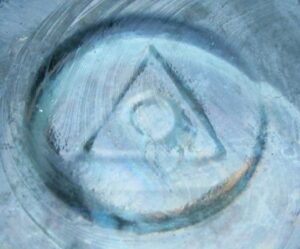
O inside a triangle, unknown meaning, embossed on the base of a soda bottle from Providence, Rhode Island, dating circa 1895-1901.(Photo courtesy of Taylor McBurney) - O with an I inside…………………Owens-Illinois Glass Company (now Owens-Illinois, Inc.), Toledo, Ohio and other plant locations. This “I inside an oval or O” mark was phased in beginning in the year 1954 (according to Julian Toulouse), although apparently it was several years before ALL of their bottle molds in use carried the “new” mark, which was basically the same as the “old” mark but with the diamond removed. (See the Owens-Illinois Glass Company page where this and several other marks are discussed in more detail).
- O and I entwined with a diamond…………… please see the Owens-Illinois Glass Company page for a number of photographs showing this very commonly encountered mark.
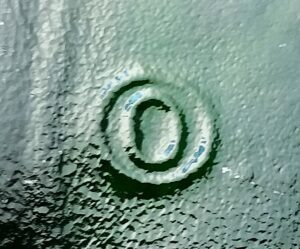
“O inside an O”. This mark as seen on the bottom of an emerald green Jagermeister bottle. - O inside a circle or oval (small “o” inside a larger O or circle)………………….Saint Gobain Oberland AG (now Verallia Germany / Verallia Deutschland AG), main factory at Bad Wurzach, Germany. There are four slight variations in the mark: One small dot or period placed to the lower right of the mark indicates production at their Neuburg factory; two dots indicates glass made at Essen; three dots indicates Wirges and no dot indicates the main plant at Bad Wurzach. The dots may be indistinct and thus hard to make out on some bottles. I don’t have info on exact date range for this mark, perhaps early 2000s?
- O.B.CO……………..Ohio Bottle Company, Newark, Ohio (1904-1905). Short-lived merger of 3 factories. Later merged with several other plants to form the American Bottle Company.
- O. B. & Co. …………….Unknown meaning. An amber bottle made in the form of a cannon and marked “O.B.& Co.” on the base is recorded by Stephen Van Rensselaer on page 301 of “Early American Bottles and Flasks, Revised Edition” published in 1926. He stated the bottle held a pint and measured 10.5 inches tall. I haven’t found mention of this particular bottle anywhere else.
- Obear-Nester………………please see “N in a square“.
- O C Co (in monogram)………………..see O G CO monogram, below, used by Ottawa Glass Company, Ottawa, Illinois. On some bottles the “G” may look more like a “C” although there is usually a small “tail” on the lower right of the letter that can be hard to discern.
- O D ……………….Old Dominion Glass Company, Alexandria, Virginia (1901-1927)
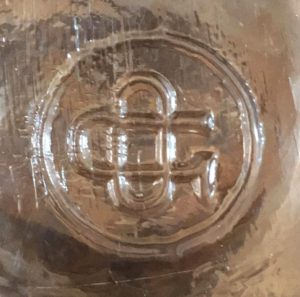
Olean Glass Company mark — OG inside circle (Photo courtesy of Melissa Pearson) - OG in a circle, entwined (monogram, shown)……………Olean Glass Company, Olean, New York (1929-1942). This mark was used by the second company that used the name “Olean Glass Company”. The mark may be somewhat indistinct on some containers, with the “G” looking more like a “C” or a sideways “U”. Also reported as being found both with and without the circle. This mark (in the photograph shown) as it appears on the bottom of a clear “generic” type of wide-mouth packer jar used likely for such items as applesauce, coffee or other food products. See “O G CO” entry also.
- OG (along lower heel of soda bottles, preceded and followed by various numbers)…………Graham Glass Company, Evansville, Indiana, Okmulgee, Oklahoma glass plant. See Graham.
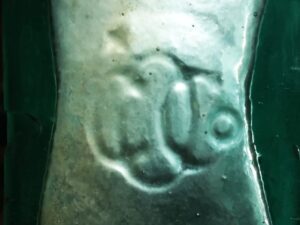
O G CO (monogram), used by Ottawa Glass Company of Ottawa, Illinois. This pic shows the mark on the base of an aqua “Coffin” or “Shoofly” type whiskey flask. - O G Co (as a monogram, with a larger “O” in the center, superimposed/entwined with a smaller “G” on the left and “Co” on the right). The “G” may be easily mistaken for a “C”. Ottawa Glass Company, Ottawa, Illinois (1868-c. 1889). The city of Ottawa is located north of Streator (another “glass factory town”) and west of Chicago, in northern Illinois. This mark (as seen on older, handmade bottles) was long unidentified with certainty, and was often attributed to the first Olean Glass Company of Olean, New York. Information uncovered in recent years points to the mark as having been used by Ottawa instead of Olean. For more information on the Ottawa Glass Company, check out this article by Bill Lockhart: https://sha.org/bottle/pdffiles/OttawaGlass.pdf
- O G Co I …………. probably Olean Glass Company/Works, Olean, New York (1883-1913). There were two different companies known as Olean Glass. This mark was evidently used by the first Olean Glass Company, but only on a very small number of containers. (See the “OG in a circle” entry above.) It has been seen on the heel of Hutchinson style soda bottles. For more information on both companies that used this name, please check out the extensive article by Bill Lockhart and other researchers, at this link: https://sha.org/bottle/pdffiles/OleanGlass.pdf . Olean Glass also had a second factory located at Port Allegany, Pennsylvania (1896-1912), which in later years was successively occupied by Wightman Co-Operative Glass Company (1915-1917) and then Pierce Glass Company (1917-1987), currently (2021) being operated by Ardagh Group.
- O.G.CO. (on heel of soda bottles – misreading of “C.G.CO”). I have seen a handful of instances in which the “C.G.CO.” mark, in small, lightly embossed letters, was misinterpreted as O.G.CO. (by online sellers) on the lower heel of straight-sided Pepsi bottles dating from the c.1900-1915 era. The user of those initials on Pepsi bottles has not been proven conclusively but in most cases was probably Coshocton Glass Company of Coshocton, Ohio – a major producer of both soda and beer bottles. Some collectors have attributed the C.G.CO. mark seen on some soda bottles from the Southeastern US states to Carolina Glass Company, Columbia, SC. (1902-c.1911) , which is a possibility but probably not correct in most instances, as Carolina Glass was out of business before some of those Pepsi bottles were made. See this article for more information: https://sha.org/bottle/pdffiles/CarolinaGlassCo.pdf . Also see my “C.G.CO.” entries on Page Two.
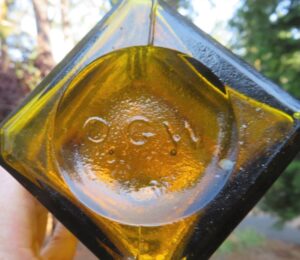
“O G W” mark used by Oakland Glass Works (photo courtesy of Dale Santos) - O.G.W. ……….. Oakland Glass Works, Oakland, California (1884- c.1885). That factory operated for only a short time and bottles with this mark are scarce. These bottles are nearly always found in California or the western U.S. Information on this mark and the timeline are from research published in “Early Glassworks of California” by Warren B. Friedrich (2010).
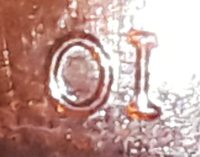
OI mark without dash, on heel of beer bottle (Photo courtesy of Dannie Richard). - OI …………. Owens-Illinois, Inc. (now generally known as “O-I”). This mark (without a dash between the letters) confirmed on the heel of an amber beer bottle. I’m not sure when this exact variant of the mark was first used, or if it was considered of any consequence or particular meaning to omit the dash on some bottles, but on the great majority of containers the letters “O” and “I” are separated by a dash. Please see next entry.
- O-I trademark ………………. Owens-Illinois Glass Company (Owens-Illinois, Inc. since 1965; in business from 1929-to date, now usually known simply as “O-I”). This is the current trademark (as of 2020) used by Owens-Illinois on their containers, registered March 20, 2007, with “first use” claimed to have been on December 17, 1997. Please see the Owens-Illinois Glass Company page for more background info on this and their other marks. On some bottles this mark is very small, or lightly embossed, and may be hard to make out clearly. At a casual glance, and viewing sideways, the mark might be perceived as part of a simple stick figure or a logo somewhat similar to the “female symbol” when turned on its side!
- O. I. G. …………………….. Owens-Illinois Glass Company (see O-I). A few soda bottles have been reported with this mark on the base. From research by Bill Lockhart, these would most likely date only from the 1929-1931 period.
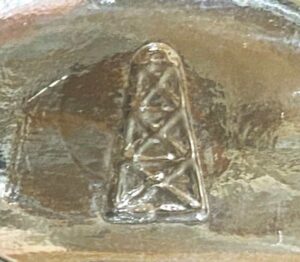
- Oil Derrick logo (shown)………………. Oil City Glass Company, Oil City, Pennsylvania (1952-1984). This factory started production in 1930 under the name “Oil City Glass Bottle Company”, which used an “O inside a keystone” logo on their bottles. In 1952 the factory was acquired by the Pyramid Rubber Company and evidently started using the new oil derrick trademark around that same time. This particular logo, a representation of an oil derrick or “oil drilling rig”, is seen on the bottom of a variety of bottles, and is sometimes misinterpreted as an electrical tower or some other type of “grid” structure. On some bottles the mark is small, distorted or faint and hard to make out. Two types of bottles frequently seen with this mark on the bottom include the “EVENFLO” brand baby bottles, and battery oil bottles (often found along railroad tracks) made for National Carbon Company. Salt shakers were also made in a characteristic “oil derrick” shape and marked on the base with the logo. (The shakers were made sporadically, over some time, and back-stocks were kept in the storage room and gradually sold over a period of time, perhaps even years after actually being made). Julian Toulouse (Bottle Makers and their Marks, 1971) wrote that this mark was used from 1952 to 1969. However, I have seen a clear flat liquor flask with the derrick mark and a 1970 date code. The Oil City Glass Company was purchased by the Questor Corporation [what year?] , and the Questor Corporation sold the factory to National Can Corporation in 1969. After 1969, the factory operated under the Foster-Forbes Glass Division of National Can Corporation, although the plant was often referred to by locals as the Oil City Glass Co. factory for many years afterward. The last glass bottles made at the Oil City factory were produced on April 13, 1984, according to information posted about a commemorative bottle listed on ebay (that listing later placed in the Worthopedia database). Evidently the oil derrick logo was phased out in the 1969-1970 time frame, although it might have taken a little while before all the bottle molds (mold base plates) in use were retooled with the “FF in a circle” logo used by Foster-Forbes. Also, please see “O in a keystone” entry, above on this page. (Also, thank you to former factory moldmaker John Pochran – I had a nice conversation with him by phone on 8/17/2022).
- Oil Well (see Oil Derrick logo, above).
- OLEAN………………Olean Glass Company/Works, Olean, New York (1883-1913)
- Omega (Greek letter “Omega” along with image of bottle placed in front of it) ……………………. Bouteilleries Belges Réunies S. A. (Belgian Bottle Factories, Reunited), Brussels, Belgium. This mark is shown on page 564 of “Bottle Makers and their Marks” (Julian Toulouse, 1971). Dates of use uncertain, possibly 1950s-1970s or later?

Greek letter Omega and image of bottle, as seen on base of Josh amber Hock wine bottle. (Photo courtesy of Josh Marquardt) - O-N………………..Obear-Nester Glass Company, East St. Louis, Illinois (1894-1978). Exact time period when this mark was used is uncertain, but a machine-made soda bottle from around 1920 carries it on the heel. Please see “N in a square” page, also, “N in an oblong”, and “N in a circle” marks.

Four Circles trademark used by Libbey-St. Clair, Inc., Ontario, Canada. (Photo courtesy of Nil E.) - OOOO (monogram that appears to be four connected “Os”, zeros or circles, or a group of closely connected rings, almost a cloverleaf, somewhat similar to the Olympics logo but with four instead of five “rings”). Some have described it as a flower bloom with four petals…………………….. trademark used by Libbey-St. Clair Inc., company headquarters in Mississauga, Ontario, Canada, factory located in Wallaceburg, Ontario, Canada (1978-c.1993). Several years ago, this mark (above) was reported to me as having been seen on the bases of restaurant glassware (such as mugs, tumblers) purchased in Canada. Sometime later I received information from reader Lisa Wallis that this mark was used by Libbey-St Clair, Inc. Currently, there seems to be relatively little detailed information online about that firm, but evidently it was formed in 1978. The site itself was originally that of Sydenham Glass Company, dating from 1895, later Dominion Glass Company, later DomGlas. From this site: https://mandicrafts.blogspot.com/2012/07/dominion-glass-company-11th-in.html , we read “In 1978 Dominion’s Wallaceburg Ontario factory was taken over by CB Pak and the plant became Libbey-St. Clair. It was renamed Libbey Canada when Libbey Inc purchased its assets in 1993.” On another site (on an Instagram post) someone wrote: ” In 1978, the glassworks in Wallaceburg, Ontario, Canada came under the ownership of the Owens-Illinois Company of Toledo, Ohio (Libbey was a subsidiary of OI at the time) and the works became known as Libbey-St. Clair.” By all accounts, the plant was closed in 1999 under the name “Libbey Canada Incorporated”.
- OP (along lower heel of soda bottles, preceded and followed by various numbers) …………. Graham Glass Company, Evansville, Indiana, this code used at their Okmulgee, Oklahoma glass plant. See Graham.
- OS (same as above). See Graham.
- OV (O and V entwined, seen on the bottom of Italian containers such as certain brands of olive oil and spring water)………………. Vetri Speciali, formerly known as Vetrerie Venete S.p.A., Ormelle, Treviso, Veneto, Italy. Dates of use for this mark are unclear, but this appears to be a mark used in recent years. For a picture of the mark, please see the “V O” entry on Page 5.
- Oval (horizontally arranged, with line drawn through longest axis, resembling a belt buckle)…………Western Glass Manufacturing Company, Valverde (Denver), Colorado (c.1900-1909)
- OVC (in vertical formation)…….. see OVG (below).
- OVGCO (monogram)…….Ohio Valley Glass Company, Bridgeport, Ohio (1881-1888). Seen on fruit jars. (See next entry).
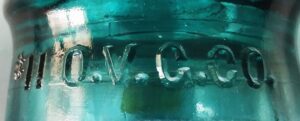
“O.V.G.CO.” on #11 aqua glass telephone insulator (CD 112) made by Ohio Valley Glass Company. - O.V.G.CO…………… The embossing “O.V.G.CO.” which appears on the front “skirt” area of several types of glass electrical insulators is an unrelated mark (to the above) and was used by the Ohio Valley Glass Company of Pleasant City, Ohio (1902-1905).
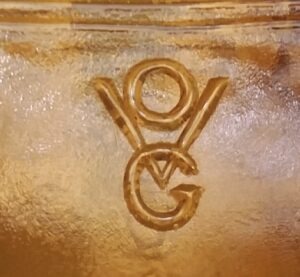
OVG monogram on the base of a “Daisy & Button” pattern baby shoe (bootie) toothpick holder in amber glass. - OVG / O V G (letters arranged in vertical formation, overlapping)………….. this mark stands for “Olde Virginia Glass” which was a line of colored decorative glassware sold by Fenton Art Glass Company of Williamstown, West Virginia (1905-2011). That particular line of glassware included such items as compotes, vases, bowls, salt shakers, candy dishes, decorative booties, shoes and hat-shaped toothpick holders. Most of the glassware sold as OVG are pieces in the “Daisy & Button” and “Fine Cut and Block” patterns. OVG was evidently sold as a slightly lower-cost alternative to their regular line, and was distributed in department stores such as K-Mart and sold in exchange for redeemed books of S & H green trading stamps. Information found online about the exact time period that Olde Virginia Glass was produced seems contradictory in some cases. Some sites/webpages report the line was introduced as early as 1960. I think that is probably incorrect. Other sources indicate it was not instituted until 1969. In any case, the OVG trademark was apparently not actually embossed on the bottom of any of this glassware until 1970 or 1971, continuing in use until 1979. I invite readers who have more definitive information on this mark and it’s exact period of use to contact me with more details.
- OWENS…………….. Owens Bottle Company, Toledo, Ohio (1919-1929) and its successor [after the merger with Illinois Glass Company], Owens-Illinois Glass Company (1929-to date). Mark is confirmed on a clear druggist bottle with date code “7.” (presumed to indicate 1947). Sometimes just the “O” of “OWENS” is enclosed within a square. I don’t know when this mark was first used during the OBC years, so will have to go with “1919-1929” until further info is uncovered. I believe the mark was used up into the 1950s or ’60s by Owens-Illinois, but have no definite info on ending date. See “O in a square”.
- P (seen on the base of an aqua mouthblown tooled-lip “Allen’s Lung Balsam” bottle, circa 1890-1910)…………… uncertain. The letter is quite small and easily missed. This might be merely a mold identifier, and not a glassmaker mark.
ADVERTISEMENT
- P (on the base of water tumblers, wine glasses and other household / bar drinkware, may appear backward so the letter is oriented correctly by looking down into the glass)…………………….. Paşabahçe (Pasabahce), brand used by Şişecam, Istanbul, Turkey. (1935-to date). Şişecam has glass production facilities in Turkey as well as I believe, Romania, Bulgaria, Egypt and Russia. I don’t have information on the earliest year of usage of this P mark. Also, please see the “Drops/droplets” mark (also used on Paşabahçe glassware) on page two.
- P (what appears to be a thin, narrow “P” with a short stroke on lower end of letter that juts toward the upper left. It also resembles a “jP” monogram). This mark is actually supposed to be a “vP” and the jar was made in Germany. Please see entry for vP (with photo of the mark) on Page Five.
- P in a circle (on base of glass tumbler, not bottle)…….. Uncertain. Is this also a mark used by Paşabahçe (Pasabahce), Turkey, as above???? If you know, please advise!
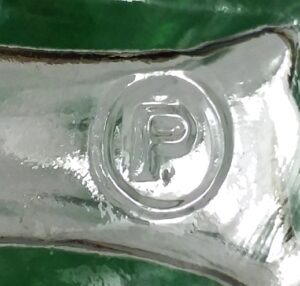
Pierce Glass Company logo, here on the base of a light green-aqua Fletcher’s Castoria laxative bottle. - P in a circle (on the base of bottles)……….Pierce Glass Company, St. Mary’s, Pennsylvania (1905-1912); Hamburg, New York (1912-1917); Port Allegany, Pennsylvania (1917-1987). This last factory was eventually acquired by Indianhead Container Corporation which merged into Ball-InCon in 1987, and at that time lost its individual identity as “Pierce Glass”. This plant was later operated under Saint-Gobain, then Verallia, currently (2020) part of Ardagh Group. The “P in a circle” mark appears on some commonly-produced medicine bottles of the early through mid-20th century, including many of the Pitcher’s Castoria, Fletcher’s Castoria, Dr. W. B. Caldwell’s bottles and others which are found quite often in dumps of that time period. For more detailed background info on this company, check out this article written by Bill Lockhart: https://sha.org/bottle/pdffiles/PierceGlass.pdf
- P in a diamond (engraved or etched on the base of upscale art glass, hand blown glass and some pressed glass cup plates) ………………….. Pairpoint Glass Works, Sagemore, Massachusetts. Most of the glassware made over the years by Pairpoint was not marked, or bore paper labels, but some items have been marked on the base with the letter P inside a vertically oriented diamond. (This mark evidently has no connection with the “P in a diamond” embossed on some glass electrical insulators, specifically certain CD 134 styles. That mark is still unidentified with certainty but may have referred to James Pennycuick, who was issued a patent concerning glass insulator manufacture in the 1880s). For some more background info on Pairpoint, here is a brief article written in 1975 by Orva Heissenbuttel: http://www.ndga.net/rainbow/1975/75rrg02d.php
- P in a flag (P in a pennant)………….Pennsylvania Glass Products Company, Pittsburgh, PA……….. (Note added 12/8/2016): There had been some speculation this mark might indicate the Pfizer pharmaceutical company, but that is incorrect. The “P in a flag” mark has now been positively identified as having been used by the Pennsylvania Glass Products Company of Pittsburgh. This information has come to me from Lynor Lisi, who sent photos showing lettering on a cardboard carton of unused “NOS” emerald green bottles bearing the “P in flag” mark on their bases. The carton appeared to have been manufactured (or packed) in June of 1971. The bottles were actually manufactured by Owens-Illinois at their Fairmont, West Virginia plant. Apparently Pennsylvania Glass Products Co. distributed vials, medicinal and laboratory bottles at the wholesale level, selling products actually made by O-I. There are listings on the web that indicate PGPC is still in business, but the exact timeline of business activity between 1932 and the present is rather murky, and the total period of use of this mark on bottles is unclear. PGPC was evidently in business (to some capacity) as early as 1932, the president of the company (Tunis J. Dykema) receiving a patent for his invention of a combination bottle stopper/rubber dropper in that year. The original patent number is 1843812, the “Re-issue” number is #19520 which can be found on “Google Patents” as RE19520. That patent number is usually, if not always, marked on the base of the bottles along with the P marking.
- P in a keystone…………….Wightman Bottle & Glass Co, Parker’s Landing, Pennsylvania [in Knox Glass Bottle Company group] (1932-1951)
- P in a square……….Pine Glass Company, Okmulgee, Oklahoma (1927-1929). Maker of “Pine Mason” jars. Factory purchased by Ball Bros Glass Company in 1929, later one of their most important plants.
- Pacific Glass Works S. F. ……………………. Pacific Glass Works, San Francisco, California (1862-1876). Embossed in a circle on the face of fruit jars. A rare jar has the mark on the base. A rare variation is embossed “Pacific Glass Work”. Most of those jars probably date from the 1870s. A few blob top soda bottles are also known with the mark “Pacific Glass Works”. Contrary to information presented by Julian Toulouse in Bottle Makers and their Marks (1971), the mark “P. G. W.” is no longer believed to have been used by Pacific – see that entry below on this page. More info on the Pacific jars and slight variants can be found in Bill Lockhart’s exhaustive article here: https://sha.org/bottle/pdffiles/PacificGlassWorks.pdf
- PARA (on base of amber beer bottle shard, probably 1880s-1910 era)………… Unknown.
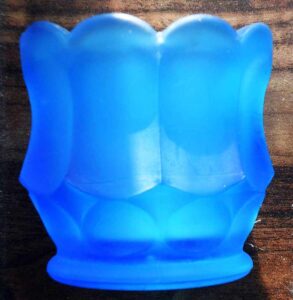
Paragon Candles / NO 237 / Oshkosh, Wis.” on base of votive candle holder. - Paragon Candles / No. 237 / Oshkosh, Wis. ……………… this lettering appears (rather lightly embossed) on the base of a frosted “satin” blue candle cup (votive candle holder) which might also be identified by collectors as a toothpick holder. The design is somewhat similar to the toothpick holder in the EAPG pattern “Kanawha” made by Riverside Glass Company in the very early 1900s. The upper rim has nine “scallops” or “petals”. These pieces were evidently produced by an unidentified glassmaker for the Paragon Products Corporation based in Oshkosh. The candle holders seem to date from the 1960s-1970s time period, although I don’t have any definite info on when they were made. Another “tulip” style with four “petals” is marked “No. 239”. There is little information available but this firm seems to have been a maker and distributor of wax candles and candle-related items for quite some time, beginning in the late 1930s or early 1940s. This company was apparently a parent company (or affiliated firm) with Victrylite Candle Company of Oshkosh. Some other glass items sold by Victrylite were marked “Made in Italy” so it is possible these votive candle holders were also made by an unidentified glass company in Italy. These were probably made in a range of colors.
- Paris…………..brand name seen on bottom of druggist bottles, assumed to be the name assigned to a line of such bottles made by an unidentified glassmaker.
- PASTORIUS, SCHULZ & CO. PITTS, PA. ……………………. Pastorius, Schulz & Company, Pittsburgh, Pennsylvania (1864). This was the first of three firms that operated the Iron City Glass Works, located on Twenty-Seventh Street near Jane Street in what was then known as East Birmingham. The glassworks operated until about 1868. (This “Iron City Glass Works” is not to be confused with a second, unrelated factory with the same name in Fayette City, PA which started c. 1874). The marking, arranged in a circular formation on the base, has been found on black glass (very dark olive green) cylinder whiskey bottles. (Information from Jay Hawkins in his 2009 book on Pittsburgh-area glass companies).
- PAT DES 187,302 (seen on the base of clear or amber bottles). This patent design number identifies bottles (which have an “hourglass” shape) that were used for both Windex Cleaner (in clear glass) and later for Crisco Oil bottles (in amber glass). The design was patented in 1960, but was used for many years. A number of glass manufacturers made these bottles and most of them probably date from the 1960s and 1970s. The bases may be found in trash dumps and among “beach glass”.
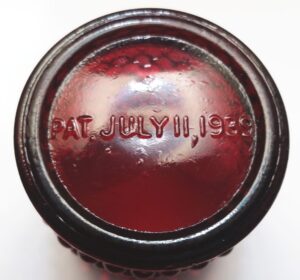
Pat. July 11, 1939 on base of votive made by Crescent Glass Company. - PAT. JULY 11, 1939 (on base of hobnail votive candleholders)…………………….Crescent Glass Company, Wellsburg, West Virginia (1908-19??, later renamed Brooke Glass Company, dates of operation uncertain but prolific in the 1980s and 1990s, out of business before 2016). Please see the Hobnail Glass Votive Candle Cups webpage.
- PAT’D APR. 23 ’78 (on bottom of tableware, such as milk glass pitchers, covered bowls, etc in the Melon pattern). Please see webpage on Atterbury & Company, Pittsburgh, Pennsylvania.
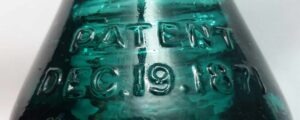
“PATENT DEC 19 1871” on CD 132 telegraph insulator made by Hemingray Glass Company. - PATENT DEC 19, 1871……………… as seen on glass electrical insulators . This marking positively identifies the insulator as a product of the Hemingray Glass Company. Most insulators with this marking were made between 1871 and the early 1890s.
- PATENT MAY 2, 1893………………..marking frequently seen on glass insulators. This patent date positively identifies the insulator as a product of the Hemingray Glass Company, Muncie, Indiana. The patent was referring to the invention of “drip points” (“teeth” or “beading”) added to the base of most Hemingray insulators. Millions of insulators were marked with this patent date, primarily as a marketing ploy.
- Pawn chess piece………see Capstan Glass Company.
- PB (P B) ………………… uncertain meaning. Seen on the base of a clear mouthblown picnic (“pumpkinseed”) flask, probably from the 1890-1910 period. Two possibilities include Point Bottle Works Company (below) and Parker Bros. Glass Manufacturing Company, Bridgeton, New Jersey (1885-1916). More background info on this and other “P” marks is in this article from Bill Lockhart et al: https://sha.org/bottle/pdffiles/POther.pdf
- P.B.W………………Point Bottle Works Company, Rochester, Pennsylvania and Beaver Falls, PA (at second location 1899-1906). Originally known as Rochester Flint Vial and Bottle Works (1879-c.1882), later, Rochester Point Bottle Works Limited (c.1882-1906). The PBW mark appears on the base of clear coffin flasks. For more detailed information on this firm, as well as many other glass companies, many highly obscure, please refer to Glasshouses & Glass Manufacturers of the Pittsburgh Region 1795-1910 (2009) by author/researcher Jay W. Hawkins.
- P/C in duo-segmented parallelogram……….Pacific Coast Glass Works (1902-1925) and Pacific Coast Glass Company, San Francisco, California (1925-1930). This mark was introduced in 1919, and used on ware until about 1930. Source on 1919 date: Peterson (1968:49).
- P/C in a square……..Pacific Coast Glass Works (1902-1925) and Pacific Coast Glass Company, San Francisco, California (1925-1930). This mark was used possibly as early as 1919, but was definitely in use by 1925. See other “P.C.” entries.
- P C in a triangle……….Pacific Coast Glass Works (1902-1925) and Pacific Coast Glass Company, San Francisco, CA (1925-1930). Mark was first used in either 1919 or 1925.
- P.C………………..Pacific Coast Glass Works (1902-1925) and its successor Pacific Coast Glass Company, San Francisco, CA (1925-1930). The PC mark probably dates from either 1919, or 1925, and on up to 1930.
- P.C.C. ……… see “P.G.C.” mark, below.
- PCC or PGC (inside diamond) ……………… see “IPGCo inside diamond” entry on Page Three. Often the “I” and the “o” are barely discernable and the mark may be hard to identify.
- P.C.G.W…………….Pacific Coast Glass Works, San Francisco, CA (1902-1925). See “P.C.” marks.
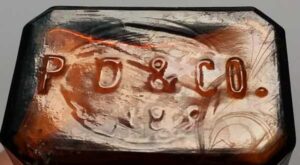
P. D. & CO. – initials on base of mouthblown Parke Davis & Company rectangular amber “Blake” style glass medicine/druggist bottle. - P. D. & CO. ………………….. Parke Davis & Company, Detroit, Michigan (1875-to date). These initials are seen on a variety of medicinal bottles of various shapes and sizes. They are found in several colors including aqua, teal green, emerald green, amber (brown), cobalt blue and clear. Parke Davis was (and is) known for an extensive line of pharmaceutical products. I don’t know what glass manufacturers produced bottles for Parke Davis, but no doubt a number of companies made containers for them over the years. Whitall Tatum Company and Carr-Lowrey Glass Company are two candidates as possible makers of some of their bottles. Most, if not all of the bottles with the P. D. & Co. marking on the base are handmade with tooled lips and probably date before around 1920 at the latest. Parke Davis & Company was acquired by Warner-Lambert in 1970, and W-L, in turn, was acquired by the pharmaceutical giant Pfizer in the year 2000.
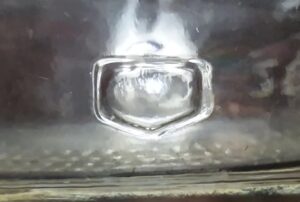
Pentagon (five-sided) trademark on heel of clear baby food jar. - Pentagon (mark in the shape of a pentagon – as seen on heel of clear baby food or formula jar, above)…………currently unidentified. Possibly from a glass company in Europe, circa 1970s-1990s? Information needed!
- Petticoat (embossed word on glass electrical insulators) …………… a handful of glass manufacturers made insulators bearing this marking. The great majority of insulators so marked were made by Hemingray Glass Company. The term “petticoat insulator” in these instances, is merely referring to any of various styles of insulators with one (or more) “inner skirts”. That is, by looking upward into the base, an additional inner “ring” or “curved wall” of glass can be seen. The most popular styles with this marking would be the “H.G.CO. // PETTICOAT” insulators made by Hemingray, especially the CD 145 and CD 162 styles.
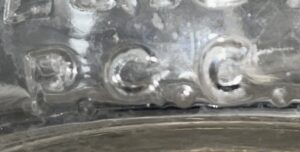
“P G C” mark on heel of SHEFFIELD milk bottle (Photo courtesy of Chris Carrara). - P.G.C. …………………. almost certainly Peerless Glass Company, Long Island City, New York (c.1920-1933). Seen occasionally on soda bottles, but evidently quite rarely on milk bottles. Steve Caldas informed me that he had found an example of a clear quart Borden’s Store milk bottle with the letters “P.G.C.” embossed along the lower heel along with “REG. U.S. PAT. OFF.” That bottle bears vertical ribbing. At first glance the marking appears to be “P.C.C.” but the second letter is actually intended to be a “G”. There is a number “32” on the base which is probably a date code for 1932. I also heard from Chris Carrara (4-2024), who had found a SHEFFIELD dairy bottle with this mark along the lower heel but with “33” on the base. For more background info on Peerless Glass, please see this article by Bill Lockhart et al: https://sha.org/bottle/pdffiles/PeerlessGlass.pdf
- P. G. Co. …………..Peerless Glass Company, Long Island City, New York (c. 1920-1933). The mark “P. G. Co” is illustrated, in a circular orientation on the “northwest” corner (10:00 to 12:00 position) of bottle bases, in a catalog page from an Owens-Illinois Glass Company bottle catalog / circular, undated but evidently from the early 1930s. Also, see next entry.

P. G. Co. mark on base of clear mouthblown druggist bottle, probably made circa 1890-1910. Maker uncertain – possibly Pennsylvania Glass Company, Anderson, Indiana. - P.G.Co………………..Uncertain. (Seen on base of colorless handblown druggist flask, above). Some bottles might be a product of the Pennsylvania Glass Company, Anderson, Indiana (1888-1915). They were heavy producers of flint (clear) prescription/druggist bottles. That company moved to Dunbar, West Virginia and operated there from 1915-1922. Also, “P.G.CO.” was probably used by Poughkeepsie Glass Company (1880-c.1913) on some of their bottles, including “Union Made” flasks from the early 1900s.
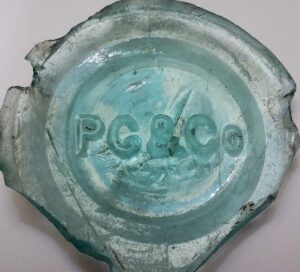
“P.G.& Co.” on base shard of aqua bottle or jar (so far – unidentified) - P. G. & Co. ………………Unknown. The shard illustrated at right appears to be the base of an aquamarine fruit jar or bottle, handmade, probably dating from the c. 1880-1910 time period. No info on what the initials stand for. It was found in a Louisville, KY dumpsite among debris dating from that general time period. If anyone else finds a whole or partial example of this mark, please contact me through my email address, shown on the “Contact Information” page. [Adam C. , I tried to contact you about this piece, with no reply – if you see this, please try emailing me again].
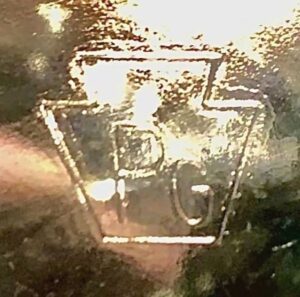
“PG inside a keystone” mark, here as seen on the base of a blue glass decorative vase. (Photo courtesy of Terri Beth). - PG in a keystone (shown above) …………………….Plum Glass Company, Plum, Pennsylvania (1985-2002?). (The city of Plum is a community in the eastern part of the Pittsburgh metropolitan area). Plum produced a variety of handmade pattern glass tableware, novelties and art glass in many different colors. Plum Glass was formed not long after Westmoreland Glass Company closed down operations in 1984. John J. Biondich, an employee of Westmoreland for 28 years, along with a brother and three of his sisters, established the new firm, using molds acquired from Westmoreland. After 18 years of production as owner of the firm, sadly, Mr. Biondich passed away on June 27, 2002. I believe the glassworks closed permanently that year, but haven’t found definite confirmation for that information. Most of the glass produced by Plum Glass is marked with the “PG in a keystone” along with the Westmoreland mark, but some pieces may carry only the PG keystone mark.
- P.G.W………………………………… probably either Pioneer Glass Works, Birmingham, Alabama (1888-c. 1891) or Piedmont Glass Works, Tallapoosa, Georgia (1891-1892). Although Toulouse wrote that a “P G W” mark was used by Pacific Glass Works of San Francisco, this is now considered very doubtful because fruit jars made by that company are marked with name of the company spelled out. If Pacific did make any bottles marked “P.G.W.”, which is highly unlikely because none have been confirmed to date, they would almost certainly be found only in the western US.
- P. G. WKS. ………………………… Poughkeepsie Glass Works / Company, Poughkeepsie, New York (1880-c. 1913)
- Philada Glass Works/Burgin & Sons………………Philadelphia Glass Works, Philadelphia, Pennsylvania (1844-1910). Operated under more than one proprietorship, this factory started as Burgin & Pearsall in 1844 and became Burgin and Sons in 1853. Most commonly encountered bottles with this marking are the blob top soda and mineral water bottles that appear to date from the circa 1855-1875 period.
- Pick axe or mattock (inside triangle with rounded corners)……………. mark seen on bottles made in Germany. See “Anchor inside triangle” symbol on page one.
- Pitcher’s Castoria………..for more information, please see page on Fletcher’s Castoria bottles.
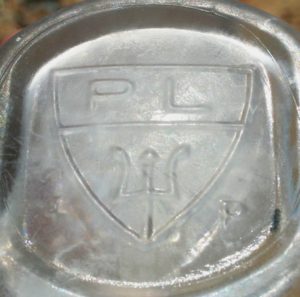
PL and trident inside shield (Photo courtesy of Richard Shepard) - P L (above trident / pitchfork, inside crest / shield)……………. Petrolagar Laboratories, Chicago, Illinois (c.1930s-1950s). This mark appears on the base of squarish machine-made glass jars of several sizes, most of which are marked either “PHYSICIANS’ SAMPLE” or “HOSPITAL DISPENSING UNIT” across the front. The jars have been seen in clear, amber, and light green glass (possibly other colors). Here, the pic sent to me by Richard Shepard shows the mark as seen on a colorless base shard. Petrolagar was evidently a pharmaceutical-related supplies distributor, not a glassmaker, so the actual glass manufacturer of these jars remains unidentified. Please see comments left by Mary Starr, from July of 2019, and Chris A, posted March 3, 2021, in the Comments section at the bottom of this webpage. The mark may date from sometime in the 1930s to the 1950s. Some brief information on Petrolagar Laboratories is related in this article on various “P” marks by Bill Lockhart, at this URL: https://sha.org/bottle/pdffiles/POther.pdf
- Plus sign (+)………………………….see “X” entry.

Base of “PLUTO” bottle showing representation of Pluto or a devil. - Pluto…………………………….Pluto Water was the name given to a natural mineral spring water bottled at French Lick, Indiana between 1913 and 1971. The water was sold primarily as a laxative because of the mineral salts dissolved in the water. Although the spring water in that area had been known and drank by European settlers as early as the mid-1800s, if not before, it wasn’t until 1913 that a modern bottling plant was built in the vicinity, and soon after the water was being bottled in tremendous quantity. Many of the earlier “Pluto Water” bottles were made in a characteristic light green colored glass and are products of Root Glass Company of Terre Haute, IN , but some of the later ones were made by Owens-Illinois. Other glass companies probably also made some of these bottles over the years. There are several different sizes of bottles found. The base of the bottle pictures the representation of “Pluto”, the Roman mythological god of the underworld. The picture is often interpreted as a “devil” with horns and a forked tail. Typically the word “PLUTO” is placed below the graphic. There is some variability in the exact design of the image, as many different molds were made for this type of bottle.
- Po’Keepsie…………………. Poughkeepsie Glass Company, Poughkeepsie, New York (1880-c. 1913)
- Pontil Marks (“Open Pontil” or “Iron Pontil” marks)………….. for a very basic page with illustrations of “Open Pontil” and “Iron Pontil” marks or scars seen on the bottoms of some antique glass bottles made in the US, please see this page: Pontil Marks on Antique Glass Bottles.
- PORT……………….Port Glass Company, Muncie, Indiana (1890-1902); Belleville, Illinois (1902-1904). Plants bought by Ball Brothers Glass Manufacturing Company in 1904, closed in 1910. Many fruit jars were made at this factory.
- POSTAL (marking seen on glass electrical insulators)……….most of these were made by Brookfield Glass Company for the Postal Telegraph Company (1886-1945) and typically date from the 1895-1920 period.
- Potter & Bodine………………. Potter & Bodine, Bridgeton, New Jersey (c.1855-1863). This was one of the firm names under which the Bridgeton Glass Works operated. Later became known as the Cohansey Glass Works. “Potter & Bodine” mark is seen on fruit jars and on the base of cylinder whiskey bottles.
- P & R / BRISTOL ……………Powell & Ricketts, Bristol, South West England, UK (c. 1856-1923). This particular mark may date from the 1850s into the 1880s or later. This company was just one incarnation in a series of glass firms based in Bristol, the earliest dating from the late 18th century. For more background info on these companies, see this article by Bill Lockhart et al : https://sha.org/bottle/pdffiles/RickettsFirms.pdf
- Pres Cut (Pres-Cut)…………………Trademark / Brand name assigned to a line of upscale glassware patterns produced by McKee Glass Company, Jeannette, Pennsylvania. This marking appears on the base of many of these pieces, generally, most of it made during the period of c.1903-1920. The patterns, known collectively as the “Tec” patterns, made use of elaborate “imitation cut glass” designs, similar in general appearance to the finely-crafted cut glass that was very popular during that time frame. The 18 pattern names for this line include: Aztec, Bontec, Carltec, Doltec, Fentec, Glentec, Martec, Nortec, Plutec, Plytec, Quintec, Rotec, Sextec, Startec, Toltec, Valtec, Wiltec, and Yutec. They are very ornate, and often confused with each other. Here is a webpage with illustrations of at least one piece in each pattern: http://glassandpotterysellers.org/newsletter/17_aug2004.htm Also, please see next entry. Also see “Nucut”.
- Prescut (note this is one word, not separated by a dash, as above entry) more accurately called “Early American Prescut”, this is an unrelated, later tableware glass pattern made by Anchor Hocking Glass Corporation, beginning in 1960, and still in production as late as 1999. It is extremely common and many pieces are very inexpensive. They are usually not marked. A very similar pattern is called “Oatmeal”. Much of this ware was originally distributed as free giveaways as part of sales product promotions, especially in the 1960s and 1970s. For more information on this pattern, written by Cathy Linehan, see http://www.ndga.net/articles/gmeapc1.php. Glass author/researcher Gene Florence discusses and pictures many of the pieces in this pattern in his reference book Collectible Glassware from the ’40s, ’50s and ’60s. Note: this line is unrelated to the much earlier “PRES-CUT” line (two words) produced by McKee Glass Company, discussed in the above entry.
- “Prism” (a raised embossed mark that is often listed as a “prism” in insulator-collecting related literature, but actually was supposed to represent a typical rectangular cut emerald gemstone)……………… this mark appears on the skirt of some Knowles brand (C. S. Knowles, Boston, MA) electrical power line insulators, and these pieces are believed to have been made by Novelty Glass Company of Elmer, New Jersey in the very early 1900s.
- Putnam………………..Lyndeborough Glass Company, South Lyndeboro, New Hampshire
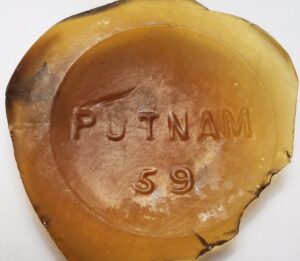
Base shard from amber-colored fruit jar, probably circa 1880s-1890s. The “59” is a mold number. (1866-1886), embossed on the base of “Trademark Lightning” fruit jars. HOWEVER, this mark was also used on large numbers of similar “Lightning-style closure” jars made by a dozen or more other glass companies. Please see my webpage about the “Trademark Lightning Putnam” jars. The “PUTNAM” mark is also reported on early mouthblown amber beer bottles circa late 1800s or early 1900s. NOTE: There are also reproduction “Lightning” style jars with the marking “PUTNAM 227” on the base. Those are relatively modern, made of amber glass, and were evidently made in Asia, likely dating from sometime in the 1960s-1980s time frame. (Assuming these were made from an old Lightning jar mold sold to a company in Asia, there exists the possibility that authentic Lightning jars with the number 227 do exist and may be found occasionally…….although a close inspection would likely show them to be old production by subtle clues of age such as the presence of high-point base wear and light scratching, besides being made of the typical aqua “bottle glass” in which most lightning jars are found).
- Putnam Glass Works, Zanesville, O. ……………….Putnam [Flint] Glass Works, Zanesville, Ohio (c.1852-c.1871). Marking is arranged in a circle, and appears on the base of a wax sealer fruit jar. This factory went through many business name/owner changes and the exact period when these jars were made is uncertain.
- P & W …………………….Powers & Weightman, Manufacturing Chemists, Philadelphia, PA (c.1847-c.1907), firm operated under several other business partnership names before and after those years. “P&W”, accompanied by mold numbers, seen on the bottom of small cobalt blue medicine bottle, handmade, similar in appearance to Bromo Seltzer bottle, likely circa 1890-1915 era.
- PYREX…………………………..brand name used by Corning Glass Works on a wide variety of glassware including bakeware, dinnerware, laboratory, medicinal and chemical bottles, and industrial glass including electrical insulators. For more info, please see webpage on Corning Glass Company/Works, Corning, New York (1875-to date).
- Q ……………..Unknown. Reported on base of drugstore bottles, principally from northern Illinois area.
ADVERTISEMENT
- Quarrier, Ott & Co……………Quarrier, Ott & Company, Wheeling, (West) Virginia (1850-early 1860s?). One of the business firm names that operated the Union Glass Works of Wheeling. This marking has been confirmed on the base of a scarce cylinder whiskey bottle.
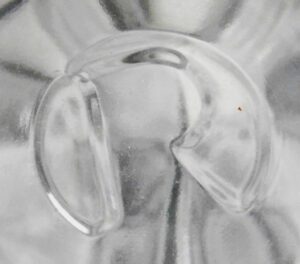
Stylized R mark – Rosendahl, Copenhagen, Denmark (Photo courtesy of Elizabeth Bruhmuller) - R (highly stylized, as shown above) , this mark is seen on upscale tableware including tumblers……………… Rosendahl, Copenhagen (København), Denmark (Danmark), 1984- to date. This mark appears, when turned sideways, as somewhat similar to a capital “C” or “G”. (Thanks to Elizabeth Bruhmuller for photo and attribution).
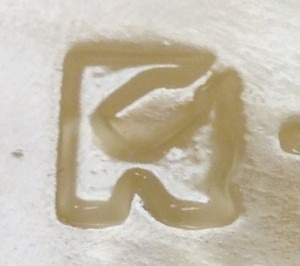
“R” mark used by Richards Packaging (Photo courtesy of Irena Shein) - R (odd-looking trademark, sometimes may look like either an R or a K, with a bottle-shaped “notch” extending downward from the upper right side, shown)……………….. Richards Packaging, Mississauga, Ontario, Canada (originally operating under the name Richards Glass Co. Ltd, formed in 1912). Richards is a distributor of glass and plastic containers, and has a number of distributing locations scattered throughout Canada and the United States. Most of their glass containers with this mark were made in China, and to some extent, some other Asian countries. This particular mark is often (but not always) accompanied by a four-digit number, and dates after 2005. Earlier containers, with their earlier trademark, an “RP” (see RP mark) date after 1982, and were made in Taiwan. Their website can be found at https://www.richardspackaging.com/ . For even earlier marks, please see “R.G.Co.T” and “RIGO” entries on this page.
- R………………….. (on handmade bottles) probably Rochester Glass Works, Rochester, New York (1862-1908). A “Doyle’s Hop Bitters” bottle is seen with a lone letter “R” embossed on the bottom. Since the maker of Doyle’s was based in Rochester and was sold beginning about 1872, this seems like the most likely meaning. Also see “Rochester Glass Wks”, “Reed” and “R in a triangle” entries.
- R in a circle………………Rockware Glass, Limited, Greenford, Middlesex (London), England (c. 1919-2006). Became part of Ardagh Group in 2006. Julian Toulouse (Bottle Makers & Their Marks, 1971, page 434) writes that this mark dated from “1930 to date”. Some information on Rockware and a company timeline is at this page: https://www.gracesguide.co.uk/Rockware_Glass . Also, see the “Hooks” entry on page three.
- R in a diamond……………Unidentified, but evidently stands for a glass company in Italy. Seen on the base of emerald green wine bottle, possibly circa 1960s-1970s. If anyone can identify the glassmaker who used this mark on their bottles, please contact me!
- R in a keystone……..Rosso Wholesale Glass Dealers, Inc., Port Vue, Pennsylvania (1969-to date). This mark is seen on glass “hen-on-nest” covered dishes and other decorative items. Rosso (strictly a wholesaler, not a manufacturer) has glassware made for him by various glass companies, including Mosser, Summit, Fenton and L. E. Smith.
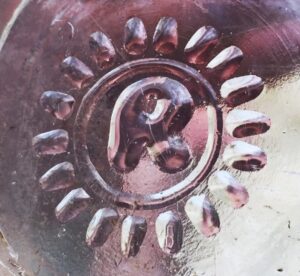
R inside a “sun” representation. (Photograph courtesy of Penny Garcia) - R within a “Sun” or Sunburst………….. This mark is seen on the base of several styles of bottles, including cylindrical bottles that, judging from the style, probably contained floor wax, furniture polish or a similar product. The mark is also seen on bottles with the accompanying markings “DES PAT” and “94,231”, referring to a bottle design patent that was issued to Glenn A. Mengle on January 1, 1935, and assigned to Wizard, Inc, of Chicago, Illinois. Some later bottles indicated they had contained products made / sold by Midway Chemical Company of Chicago. A rectangular bottle containing a brand of multi-purpose oil (“Radiant Machine Oil”) has been recorded, made by Midway Chemical. The bottle package shows the design of the word “Radiant” placed within a sunburst. These bottles have been made by Owens-Illinois Glass Company and possibly Brockway Glass Company, and presumably date from the 1935 to mid-1950s era. Although the Mengle connection is referring to a “patent” of a bottle design, this “R in a sunburst” logo would assumedly be classed as a “trademark“, of which specific detailed information has not been found as yet, at least to my knowledge. It seems that the “R in a sun” has been used as a trademark on a number of different household/cleaning-related products sold through both Wizard and Midway over the years.
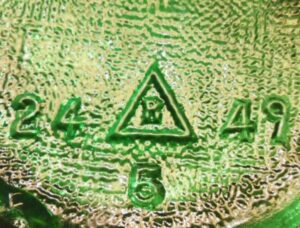
- R in a triangle…………..Reed Glass Company, Rochester, New York (c.1927-1956). The 1927-1956 date range is given by Julian Toulouse in Bottle Makers and their Marks (1971). However, I received a report from Taylor McBurney who confirmed a similar mark appears on an older, square handmade bottle (prob. circa 1890-1915) so, assuming Reed was the maker of that bottle, they apparently used the “R in a triangle” much earlier than stated by Toulouse. The “R in a triangle” on that bottle could also indicate another unidentified and entirely unrelated company. See also “Reed”, Rochester Glass Works, “C-H” marks.
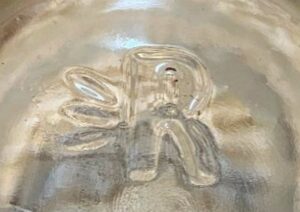
“R” with 3 feathers or leaves to the left. (Photo courtesy of Jim Knapp) - R (with three feathers or leaves to the left of the R)…………………….. unidentified trademark. This appears on the base of a generic packer jar made by Armstrong Cork Company, perhaps circa 1950s or ’60s. The mark is likely that of a food processing or distributing company. If anyone knows the identity of this mark, please let us know!
- Randall (some pieces are marked “A. L. RANDALL CO. PRAIRIE VIEW, ILL”) …………. seen on the bases of white milk glass and transparent emerald green glass florist vases and bowls. This seems to have been a company, located in the metro Chicago area, that specialized in selling products for the florist industry (including both glass and ceramic planters) at least for some length of time during its existence. One reference indicates the company was in business for over a hundred years, beginning in 1888 – according to info on this webpage: (https://historyillinois.org/centennial-business-awards/) . Also, an entry on the Justia.com site listing trademarks indicates they applied for the trademark “RANDALL” in 1991, claiming first use in 1948, but that trademark has since been listed as “Cancelled”. Since the Randall company was certainly not a glass manufacturer, but a distributor/wholesaler, the glass with their company name on the bottom was made by an unidentified glass maker. If you have information on what company (or companies) actually made the glass marked “Randall”, please advise! The glass is similar in “look” to that marked “E. O. Brody” and “Hoosier Glass”, and I suspect (with no proof) some of it might be products of Indiana Glass, or Anchor Hocking. Also, there are obscure references online to a “Randall Glass Company” of Randall, West Virginia in the early 1900s, but that company seems to have absolutely no connection to this concern.
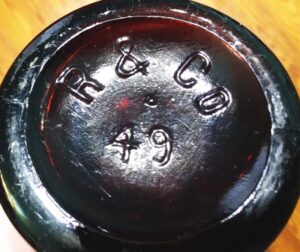
Base of R&CO bottle made by Reed & Company, Massillon, Ohio. - R & CO (usually seen on the bottom of beer bottles, as shown at right)………………Reed & Company, Massillon, Ohio (1881-1904). See this page for more info.
- Rawleigh’s (W.T.Rawleigh’s / Freeport, Ill ) ……………… bottles with his marking are quite frequently found throughout the United States. Please see this page for more information.
- Ravenna Glass Co. (as seen on flasks)…………………. Ravenna Glass Works/Company, Ravenna, Ohio. There were actually several different business firms using the name “Ravenna Glass Works” or “Ravenna Glass Company” that operated for stretches of time between 1857 and about 1866. For more background information see this article by Bill Lockhart: https://sha.org/bottle/pdffiles/RavennaGlass.pdf
- Ravenna Glass Company (with anchor), as seen on pictorial liquor flasks………. Ravenna Glass Works/Company, Ravenna, Ohio (1857-1866). These may have been made later within that time period.
- Ravenna Glass Works…………………Ravenna Glass Works, Ravenna, Ohio (1857-1866). Full name is found embossed on the face of fruit jars and whiskey flasks. Info on exact dates of operation courtesy of Brian Gray.
- R B (on base of square, heavy handmade green-aqua pickle bottle, Great Britain)…………Unknown. One possibility could be Roberts & Brown, Castleford, Yorkshire, England, a glass bottle maker listed in a c.1852 list of bottle makers in England, but this pickle bottle might date much later.
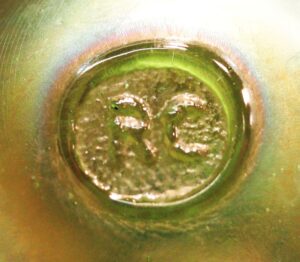
RC inside circle~Robert Coleman. On base of decorative iridescent 2-handled blown bottle. (Photo courtesy Carey Hamilton) - RC inside a circle (shown)…………….Robert Coleman, independent glass artist who specializes in handblown iridescent (carnival glass) pieces, some with an “art deco” influence. Vases, bottles, bowls, etc are found with this mark on the bottom. I’m not sure about years of production, but perhaps 1990s to present. If you have more info, please contact me!
- R inside a capital letter “C”………….. unidentified meaning. The mark appears in the center of a clear stippled bottle base that looks to be from the early or mid-1970s.
- R. Cooper & Co. Portobello ………………………..Richard Cooper & Company, Portobello, Scotland (c. 1866- c. 1885). Seen on the bases of mouthblown black glass ale and wine bottles. For more information on this and related firms (including Cooper & Wood, a predecessor of R. Cooper & Co., and the later firm known as Richard Cooper & CO. Ltd.), please see this detailed article from Bill Lockhart et al: https://sha.org/bottle/pdffiles/Cooper&Wood.pdf
- Rd. Cooper & Co. Portobello …………….. same as above.
- Rectangle (two interlocking squared “hooks” that form a horizontally-oriented rectangle….. see “Hooks” entry on Page Three.
- R E D (superimposed over a Key), as seen on Mason style fruit jars…………. See entry under “Key” on page three.
- Reed……………….F. E. Reed Glass Company (or Reed Glass Company), Rochester, New York (c.1899-1956). See Rochester Glass Works.
- REIP (or R E I P)………………as seen on base of crown-top blue-aqua tooled lip “export beer” style bottle, probably made circa 1895-1915. Unknown. (Reported by Lee Taylor). Could be either initials, or an actual surname for a brewer or bottling company?
- REX (in cursive script)…………Obear Nester Glass Company, East St.Louis, Illinois (1894-1978). Mark used from 1896 to circa 1910? Trademark used by Obear-Nester, occasionally seen on base of clear prescription bottles. Please see “N in a square” page.
- R. G. & B. CO………………………Rhodes Glass & Bottle Company, Massillon, Ohio (1901-c.1920). This mark and the following variation is seen rather frequently on bases of amber and aqua beer bottles from cities in OH, PA, IN, MI, WI, and MD that I am aware of, and probably other states as well. An obscure company which was virtually unknown to most bottle collectors, nevertheless quite a number of bottles were manufactured over a period of almost two decades. The name of the company seems to have changed slightly at some unknown time during its history, with the “&” being omitted. Or, perhaps a few bottle molds were lettered “R.G.B.CO” either by accident or for some unknown reason.
- R. G. B. CO……………..Same as above. Presumably a variation of the above mark.
- R. G. CO……………..Root Glass Company, Terre Haute, Indiana (1901-1932). Mark used by Root in the early years (1901-c.1909). Toulouse (Bottle Makers and their Marks, 1971) stated these initials stood for Renton Glass Company, Renton, Washington (1907-1911). However, the “R.G.CO.” mark which was used by Renton likely appears only on certain bottles from the West Coast. I do not believe any of the many Midwestern-origin soda and beer bottles seen with the “R.G.CO.” marking originate from Renton. See Root Glass Company page.
- R. G. Co. T (around diamond)………..seen on base of druggist bottles made in Canada. Richards Glass Company, Ltd. (later Richards Packaging), Toronto, Ontario, Canada. (1912- to date). Richards was/is a jobber/distributor and did not manufacture their own bottles, but had container ware made for them by Dominion Glass Company (D in a diamond) and later by other unidentified glassmakers. See also RIGO, R (with bottle-shaped notch), and RP entries. For more detailed information on the Richards’ marks, see this thread at the Antique-Bottles.net site: Antique-bottles.net discussion thread: Have any of you Canadian collectors seen this mark? (Thanks to Glen Phillips and Eric Kloff for their help and research!)
- R. G. W. ……………..Probably Ravenna Glass Works, Ravenna, Ohio (1857-1866). Seen on base of wax sealer fruit jars. (Dates courtesy of research by Brian Gray).
- R.I. (with number or letter and the word “SEAL”, on milk bottles) …………………………………… several glass manufacturers made milk bottles with this type of marking, required by law for bottle used / distributed within the state of Rhode Island. See list at this milk bottle site (archived and no longer live on the internet): https://web.archive.org/web/20140214150205/http://dairyantiques.com/Milk_Bottle_Marks.html
- R. I. B…………….. Rock Island Brewing Company, Rock Island, Illinois. This mark probably dates in the years before prohibition, circa 1905-1920.
- Rich’d Cooper & Co. Portobello………………another variation of “R. Cooper & Co.” (above).
- Richmond Glassworks …………….. Richmond Glass Works, Richmond, Virginia (1855-1865). As seen spelled out across the front of a figured flask, with the lettering placed within a ribbon or banner, along with an anchor design. For more detailed information see this article: https://sha.org/bottle/pdffiles/ROther.pdf
- H. RICKETTS & CO GLASS WORKS, BRISTOL ……………………….H.Ricketts & Company Glass Works, Bristol, England. This embossing is seen, arranged in a circle, on the bottom of early blackglass ale and wine bottles. Bottles with this marking are believed to date from 1821 to about 1853. This is probably the earliest type of bottle carrying an embossed glass factory identification mark on the base.
- RIGO…………. Richards Glass Company Ltd., later Richards Packaging, Toronto, Ontario, Canada. (1912- to date) . As seen on cobalt blue poison bottles. Bottles actually made by Dominion Glass Company. The “RIGO” mark apparently dates from 1912 to (at least) the 1970s. (Also, please see “R.G.Co. T” entry).
- R. Lalique (see Lalique).
- RM (monogram)………..Unknown. Reported to me as seen on beer or soda bottle base shard.
- Robinson, Geo. W. (Geo. W. Robinson / NO. 75 / MAIN ST W. VA.)……………………embossed marking on face of strapside flask. Made at the North Wheeling Glass Works (dba Geo. W. Robinson), Wheeling, West Virginia (c. 1860s- c.1910). Exact time frame when these flasks were made is open to question, but they may date from sometime during the 1865-1875 period. Some sources (i.e. McKearin) indicate the works were in business as early as 1860. But in the earlier years window glass was the predominate product; later on they switched to making primarily bottles. George W. Robinson was the owner/manager of the works sometime in the 1860s/1870s. An 1879 reference (History of the Pan-Handle, published by J. A. Caldwell) mentions “Mr. Robinson” was involved in early years, but indicates the works had just recently began operating with a new company (group of owners) under the name “North Wheeling Glass Company”, for a “short time”, meaning perhaps since 1877 or 1878(?). The last mention I can find of this operation is from c. 1910 when young boys were striking at the factory.
- Rochester NY Glass Works………………… see next entry.
- Rochester Glass Wks………………………Rochester Glass Works, Rochester, New York (1862-1908). Alice Creswick in The Fruit Jar Works (1995:273) shows this chronology for the Rochester Glass Works and succeeding firms, evidently from city directory listings researched by either herself or Dick Roller: Rochester Glass Works (1862-1881); Kelley & Co. (1882-1885); Kelley, Reed & Co. (1886-1887); Eugene Reed & Co. (1888-1889); E. P. Reed & Co. (1890-1894); Rochester Glass Works (1895-1898); F. E. Reed Glass Company/Works (1899-1900); Rochester Glass Works (1901-1908); F. E. Reed & Co. (or F. E. Reed Glass Co.) (1909-1927); Reed Glass Co. (1927-1946); and Reed Glass Co., Inc. (1947-1956). Several marks were used at various times by this factory, and the exact period of time that each mark was used is not entirely certain. Known marks include “Reed”, “F.E.R.”, “F. E. R. G. Co.”, “R in a triangle”, and “Rochester Glass Wks”. Some blob beer bottles are known with the marking “Rochester NY Glass Works” embossed in a circle on the base. The full factory name could conceivably have been embossed on bottles dating from anytime within the 1862-1908 time frame. After a time of inactivity, the Reed Glass Company plant at Rochester was purchased by Castle-Hanson Corporation in 1959, and the “C-H” mark was used for some period of time thereafter. Later, Leone Industries, based in Bridgeton, New Jersey, purchased the plant and their “L in an unconnected square” mark was used on ware produced at Rochester as well as Bridgeton. Exact dates of later operations of this factory are unclear. (See “R in a triangle”, “C-H”, and “L in an unconnected square” marks).
ADVERTISEMENT
- Rock hammer symbol (inside triangle with rounded corners, somewhat similar to a teardrop shape)…………………….. see “Anchor” (inside triangle) entry on page one.
- Ron Ray 1991 (or other year, hand-etched on base of handmade art glass bird paperweights) ……………… Phoenix Studios, Fayetteville, Arkansas. These birds, usually in blue glass, but occasionally in other colors, are similar to the pieces made by Terra Studios, also of Fayetteville. (All birds marked “Leo Ward” on the base are products of Terra Studios.)
- ROOT (pictured below)……………….for more information please see this page: Root Glass Company, Terre Haute, Indiana (1901-1932).
- RP (often with 3-digit number) on the base…………………..Richards Packaging, Mississauga, Ontario, Canada. This”RP” mark dates after 1982, and indicates production in Taiwan by unidentified glass factory(s) for Richards. Richards instituted their later “odd-looking R” mark in 2005 (as shown, above on this page). Also see “R”, “RIGO” and “R.G.CO.T.” marks.
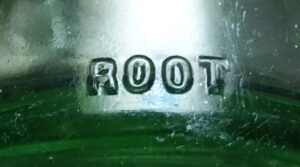
“ROOT” on lower heel of light green John G. Epping, Louisville, KY soda bottle, circa 1920s.
[ A – B ] [ C – D ] [ E – L ] [ M – R ] [ S – Z ]
Please click here to go to my HOME PAGE.
ADVERTISEMENT

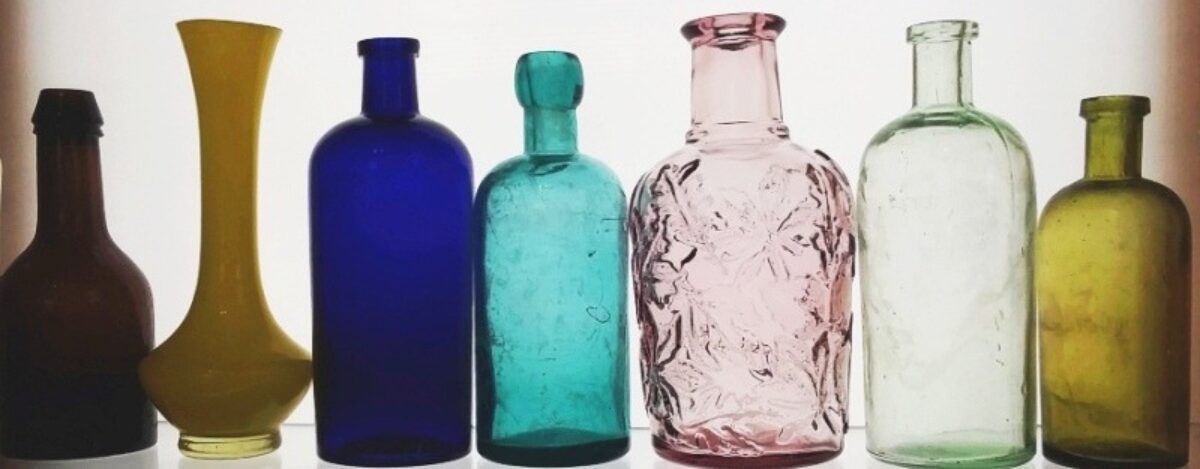
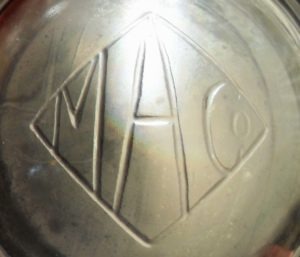
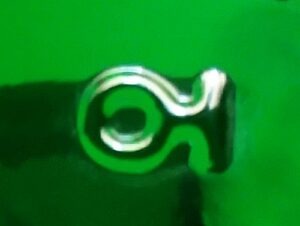
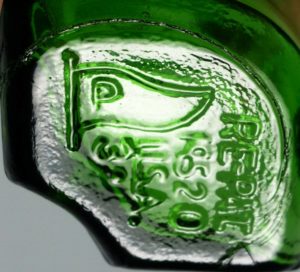
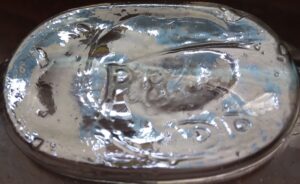

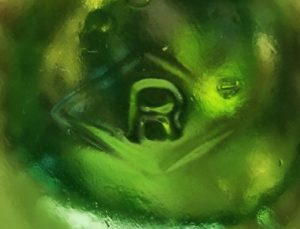
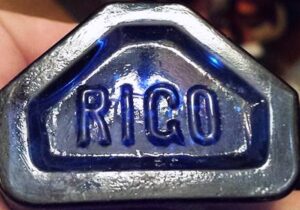
Thank you so much for your website and access to all this marvelous information. I have cobalt blue bottles (which are about 3 1/2″ at widest point of the mock vase-like shape and 7″ tall) and they have small handles on opposite sides near the ridged/ribbed shaped top (which has a screw on top that fits caps I found, to seal for use). With your site I was able to identify with total certainty that they were made at Madera Glass Company. Much appreciated!
Hi Maile,
Thank you for your kind words! I’m glad you have found this site to be useful. I have seen those types of bottles before but wasn’t sure what they originally contained. I used to think they perhaps contained an obscure brand of vinegar, olive oil, or wine! But after doing some keyword searches on eBay and Worthpoint, I found that your “urn shape” decorative bottle with two handles was originally sold containing “Blue Luna Cafe” brand “Coffee Drink” – coffee with milk. (I am presuming that is the only brand name product that style of container was used for, but I can’t state that with 100% certainty). I found two or three photos online picturing the bottle with the label still attached. I presume they date from the 1980s. Thanks again for writing!
~David
Wondering if anyone might be able to help with the identification of this piece of glass found in a river.
Light purple glass. Entwined capital Letters R C. One fifth gallon capacity.
I found a piece of light blue/turquoise sea-glass stamped with the letter R with nothing else around it, looks like the bottom of a glass bottle. I can’t seem to find out any information about it.
Hi Aimée,
It would be difficult to be sure what the “R” stands for, as the letter was used as a glassmaker ID for a number of glass companies around the world. If you wish, please check my “Contact Information” page and send me an email with photos of the piece. Thank you and take care,
David
Hello, I found a small medicine cork bottle and the bottle has a dot on both sides of a square with an O inside. Can you help with company and a date made?
Craig, the bottle was made by Owens Bottle Company, but I can’t tell you the date it was made, only a rough date range. That company used an “O inside a square” logo on their bottles. Please see my page here on Owens Bottle Company.
Thank you, David
Here’s one that I haven’t been able to find any info on. It is a 1 ounce slick druggist bottle with the strong embossing M.P. & Co. on the bottom. It is blown in a mold, and the dump that I found it at dates from about 1905.
Hi Joel,
Thanks for your post. I will add that listing to the alphabetical list of marks soon. Maybe someone will know what it represents.
Take care,
David
Hi everybody. I´m trying to place an old green bottle. I´ve been up and down the web, but can´t find what I need.
0,7l
— G — (G in a circle with a spike on each side)
5
The bottle has a bulbed neck.
Please help. This bottle is keeping me up to long in the evening.
Hi David, I recently found an amber glass gallon-size jug. The logo on the bottom is LM in a circle which I found to be Latchford-Marble Glass Co., made between 1939-1957. I’m curious what the jug may have contained? The bottom also had the #s ‘689’ and ‘5’. Any idea what these signify?
Hi William,
Those types of one-gallon jugs were made by a number of glass companies, and typically they might be classed as “generic” multi-use containers. The most common uses were for containing vinegar, apple cider, and soda syrup (such as for Coke or Root Beer soda). Other somewhat similar types of jugs were made and used to hold various chemical liquids such as bleach, hydrogen peroxide, ammonia and other general household cleaning agents, or products used in farm operations (such as liquid fertilizers) or at research laboratories. Just for fun and/or additional info, you might try searching ebay with keywords such as “vintage”, “jug” “gallon” and “glass” to see other jugs and ideas on what they may have held. A few might be found with the original paper label intact, although many have lost the label. Those types of glass jugs were also reused in many instances.
Also, the “689” is almost certainly a style or design number assigned to that particular bottle/jug mold by the glass factory. The “5” is probably a mold number.
Hope this helps,
David
Amber bottle with RVW in cursive embossed on the bottom… no other marks.
I have a jar with the Midland Glass Company logo on the top, 2 on the left, no number on the right and 10 on the bottom. All along the top are stars and it’s not screw on so can you give me any info if you can.
Hi Kaleb,
If the lid is a “snap on” with no screw threads, that actually sounds something like the jars for Armour brand dried sliced beef. Would that ring a bell? Otherwise, I’m not sure. Maybe a reader will recognize the jar you describe.
Take care, David
I’m trying to date a clear bottle marked One Quart at the top with the Northwestern Glass “NW in an oval” mark on the bottom. No other markings but this was dug up with some 8-bubble 7-up bottles and others that I’ve dated to the 1950s. Any help is appreciated!
Cindy, I can’t be of much help here if there are no other markings such as date codes on the bottle. If you are reasonably sure the bottle was found in context with other items from the 1950s, we can assume it was most likely discarded during that time period. Of course, it may be older, but presumably not newer than the 1950s.
Best regards,
David
Have you ever heard of a North Pole Bottling Co. Minneapolis,Mn?
I have a ruby red crown top bottle with a hobbleskirt shape with no marking except on the base which is marked MT.L. (The T is smaller than the other letters). Any idea who made it?
Hi Seth, I don’t know what the marking would stand for. Perhaps a reader will have more information.
~David
DAVID- I HAVE INFO ON THE PL MARK IN THE SHIELD WITH THE PITCHFORK DESIGN.IT WAS PETROLAGAR LABORATORIES, MADE FOR HOSPITALS. 1941-1950s. You stated if anyone had info to let you know!!
Hi Mary Jo,
Thank you very much for your info. I did a search online and although I found many references to Petrolagar Laboratories, I couldn’t find a photo or mention tying the PL logo with that company. I am sure you are correct, as that pharmaceutical firm would certainly fit all the qualifications. Do you know of any references or photos online that would illustrate this connection? Did you actually work for Petrolagar, or know of someone who did?
Thanks a lot for your input!
David
Hi. Following up on the PL trident mark. I have found two recently. One is a amber round base only. The other found yesterday is a completely intact small square bottle with cap, about 12 oz. Looking online, I’m sure this is it pictured from a museum, it’s mineral oil. Mine even has some oily residue inside.
https://americanhistory.si.edu/collections/search/object/nmah_1298496
Chris in NJ
Hi Chris,
I do appreciate your post and the information to add to this site!! I will eventually be re-editing my entry on the PL/Trident mark. Thanks and take care!
David
I found an old Orange Crush bottle with the glassmaker logo saying “O. C. Co.” or “O. G. Co.” This bottle could either be a Olean Glass Co. bottle with the O G Co mark, or an entirely undiscovered glassmaker. Any help with identifying this? https://i.redd.it/8tji4s6fan231.jpg
I have a 6 oz Old English bottle stamped with the R inside the sun logo. The A S Boyle Company Distributors.
Libbie, thanks for your info. Unfortunately, I still don’t know what the “R inside a sun” actually stands for. But it definitely appears on many glass furniture polish bottles.
Take care, David
I have a carboy that is marked 1990 with what appears to be a VR attached together in a circle with number 3 and DOT-1M NRC M3008 all on the bottom. Not sure if it is a 5 or 6.5 gallon? Any information would be greatly appreciated. Thanks for such an awesome site for finding out so much information on glass.
Charles, it seems I have seen a “VR” (letters connected) mark somewhere, but I can’t “place it” right now. I am sure it is a maker located outside the US, perhaps in Mexico or some other country in Central or South America, or possibly in Europe.
David
Up until 4 PM today I had a 5 gallon glass carboy with VR on the bottom. I still do not know the company name but it indicated made in Mexico. The V and the R share a common side right side of the V and the straight leg of the R. I bumbed it and a large piece came out of the rounded tob. Jug had been filled with quarters. I found a duplicate on Ebay and am negotiating to purchase it.
Hi Donald,
I believe the “VR Connected” mark was used by Vidriera Los Reyes, a glass container manufacturer in Mexico that was formed in 1944. I tried searching through some websites (my Spanish is not great), but using online translation services I THINK this may be one of several companies that combined to form Vitro Packaging. I’m guessing the mark VR was used sometime in the 1970s-1990s(?) If a reader has better, more in-depth information on this glass company from Mexico, please let us know! I will add a brief entry on my alphabetical marks list in the meanwhile!
David
R in triangle info. Dave, I found in Elmira NY, a brown square wine bottle with embossed name “Urbana Wine Co Inc” Hammondsport NY in script. On the bottom there is the R in triangle and above – 151; below at 7 o’clock is embossed 1, at 5 o’clock position is embossed 7. Bottle has casting lines on 2 corner edges and a bottle top for cork. About 750 ml size. Urbana Wine Co. was in business from 1865 to 1988. Under Gold Seal ( Seagrams) label at end. UMass Amherst has some of the original records late 1800s. Looks like 1919 onward it was Gold Seal.
Found your Rochester glass info helpful checking into this bottle.
Thanks
Steve
Love your site. Unable to locate R C Wright & Co Buffalo. I have a milk bottle with this on the bottom from Pembroke Dairy RC Purvis, 95 Dewitt
Thank you VERY much for this website. I have used is so many times. I appreciate all the time and effort you put into this to help total strangers. Thank you for your kindness.
Hi Sandy,
Thanks so much for your kind words! I really appreciate that! I’m glad to know you’ve enjoyed checking out the website.
Take care,
David
Purchased a little clear glass votive candle holder — not very impressive. Interesting part was the etching on the bottom of the glass. At first it looked like “1777” then my daughter pointed out that
it was 3 candles, What looked like numbers were straight lines with flames etched above them.
A curved line below seemed to indicate a plate the candles were sitting on. Also “TM” was
below this. Any ideas who the manufacturer of this little ordinary piece could be?
Sherry, I’m not familiar with the mark. Just guessing, I wouldn’t be surprised if it’s the mark of some glassmaker or distributor located in Asia. But don’t quote me! Perhaps someone who has more info on it will land on this site, and let us know!
Thanks for the post,
David
Add to your PRESCUT comment that Hazel Atlas made Hazel Ware with a gold foil label that reads “HAZEL WARE EARLY AMERICAN PRESCUT CRYSTAL”. Hocking bought at least one of the Hazel-Atlas locations, hence the use of the Hocking’s PRESCUT term. 1977 is probably the earliest date.
DoRi Miles, Pattern Glass Historian, Pattern Glass Editor EAPGPatterns.com .
Found a beer bottle marked “O B Co.” Which according to this was made by Ohio Glass Co from 1904 to 1905. That’s hard to believe, the bottle is dark amber is looks flawless. I cannot believe it is that old. The bottle is from J.F Wiessner & sons brewing Co Baltimore. MD.
Seth, yes, your bottle is that old. I checked out an article on the brewery, and according to this webpage, the Wiessner brewery started in 1863 and was in business until 1920 when they closed because of Prohibition.
http://www.baltimorebottleclub.org/articles/wiessner.pdf
Also, I might add that many bottles, even if they were dug, can look almost the same as they did when they were made, depending on soil conditions and the glass formula. Many will be stained from being buried for many years and being in long contact with soil moisture, but others, for some reason, can be in great condition. I’ve noticed that some “black glass” (very dark amber) bottles don’t have much staining even if they are over a century old, so perhaps the exact glass batch formula causes the glass to resist deterioration. Also, many bottles were never buried, but were stored in attics, basements, garages, sheds, closets or whatever, and might still have practically no damage or wear of any kind.
Take care,
~David
I read elsewhere…Millville Bottle Works … 1888 …. not 1903.
Hi Robin,
As you can see, there is some confusion on the dates Millville Bottle Works was in business. The confusion arises because of a type of repro beer bottle marked “MILLVILLE BOTTLE WORKS 1888” on the front and “THIS BOTTLE NOT TO BE SOLD” on the reverse.
For a bit of background, T.C. Wheaton Company was founded in Millville, NJ in 1888, specializing in druggist and laboratory ware (glass vials, test tubes etc). In 1903 Millville Bottle Works was founded in the same city, also making pharmaceutical and laboratory ware, glass tubing, breast pumps, funnels, and other chemical and lab-related glassware. In 1926, Wheaton purchased the Millville Bottle Works, thus expanding their business in a big way. Millville was also home to another major bottle producer, Whitall Tatum & Company.
As time went on, Wheaton specialized increasingly in making many types of reproduction and “fantasy” bottles, especially in the 1960s and 1970s. The bottles lettered “MILLVILLE BOTTLE WORKS 1888” were evidently made by Wheaton sometime in the 1970s, perhaps 1976 according to one source. The “W in a circle”, used by Wheaton after 1946, is marked on the bottom of those bottles. They are meant to mimic the “look” of beer or soda water bottles of the 1880s. The bottles were made in amber, sapphire blue (light cobalt) and dark emerald or forest green (perhaps other colors?).
Exactly why Wheaton didn’t embossed the bottles with “T. C. Wheaton & Company 1888” seems like a legitimate question. But because these bottles are quite common and appear often on ebay and other internet sites, some collectors naturally assume that Millville Bottle Works began in 1888. More info on Millville Bottle Works can be found in the reference book The Glass Gaffers of New Jersey by Adeline Pepper, published in 1971. In fact, I would recommend that book to all collectors of antique glassware and bottles, especially glass connected with New Jersey, as she gives a lot of interesting background information on many companies in the state.
Hope this helps!
David
I have found a small glass bottle today in the garden. Thanks to your site I can see it is a National Glassworks bottle but am curious as to the date and previous contents. It has the N in a diamond, a line underneath then a number 2. The bottle is about an inch wide and 2 inches high. Any info would be great thx.
Hi. I have a largish green bottle with stopper. On the bottom reads made in Italy, with what appears to be a makers mark. The mark could be an I and something else, a elongated U or something else. I can send pics if needed. Any ideas?
Daniel,
I don’t have much info on bottle makers in Italy. You can email me a pic of the base mark and I can check to see if it is shown in Julian Toulouse’s “Bottle Makers and their Marks” (1971). He listed some marks used by countries outside the United States. If you haven’t already, google “Emhart punt mark database” and see if the mark is listed there. However, if it’s an older trademark it may not be listed.
~David
Hi David, thanks for your thorough response to my query about the P. D. Co. bottle mark. I appreciate all of the info. -Barry
I have a wooden spice chest with 8 glass bottles from Piper Doremus & Company. The bottles are marked on the bottom with “P.D. & Co. N.Y.” So, it seems that not all bottles with that marking would be Parke Davis. I am trying to find information on Piper Doremus, but I am striking out. I’m guessing circa 1895, or so. Thanks in advance for information.
Hi Barry,
I have no information on Piper Doremus & Company, other than finding a few brief mentions dredged from a google search which seems to indicate they were in business during the late 1880s and early 1890s. The fact that your bottles are marked with “N.Y.” along with the initials seems to differentiate them clearly from Parke Davis bottles, as Parke Davis & Co was based in Detroit, Michigan and (as far as I know) a city or state location wasn’t marked on the base of bottles made for them. But I appreciate your writing to report this find. I was not aware that any other company used the same set of initials as Parke Davis.
Many, many different styles, colors and sizes of pharmaceutical bottles are found embossed with “P.D. & CO” on the base, usually accompanied by a mold ID number, and Parke Davis was the largest pharmaceutical company in the United States (and world?) for some time, so their output of medicines were vast.
Best regards,
David
I have a couple of aqua crown top bottles that say “Mendota Bottling Co.” and an M embossed on the bottom, are these bottles uncommon?
Alex, I have no idea. Tens of thousands of different crown-top soda bottles were made for many bottling companies located across the United States, and most of those kinds of bottles have the most interest (and highest collector value) to collectors in their local area or city/state. I am not familiar with that particular bottling company.
~David
As an archeologist, I record maker’s marks I find on archeological sites. I found a broken bottle with the “R-in-Sun” maker’s mark on the base that also bore the notations “DES. PAT.” to the left of the sunburst and to the right of the sunburst the numbers “94231.” This design patent was granted by the U.S. Patent Office on January 1, 1935 to an application submitted by Glenn A. Mengle on July 18, 1934. Hope that bit of info helps. Have you learned anything more regarding the manufacturer who used the “R-and-Sun” mark?
Hello Guy,
I really don’t have any more info on the “R inside a Sun” mark. Your information led me to find a few brief references to Glenn A. Mengle online, and it appears he had some connections with Brockway Glass Company, of Brockway, Pennsylvania. So, perhaps the mark was used by them, or maybe the mark stands for a distributor, wholesaler or other company that had dealings with Brockway. No solid evidence so far, but at least this might be a good lead! Thank you for your post.
Take care, David
Thank you for the updated information.
I have found a glass jar with the OG mark with a circle around it. It also has the numbers 2267, 4 and the letter P. I am finding very little information about this item. Does anyone know what its original contents were or any historical information? It was buried in the woods but the glass is in great condition. Sadly the lid was not to be found
Guy, if it is of any value, the bottle probably held furniture polish (trade marked in 1915). I searched on Wizard Inc. mentioned in the patent file, and found some links for Wizard Products Co. In the early 1900s they made furniture polish, a triangular mop, a glass (wooden handled) rolling pin (embossed with co. name on end), and “ironing wax” and “fire-extinguishing compound”.
I have asked our Bottle Research Group (SHA website on Historic Bottles) about the base mark. I assume it is like this bottle I found on Etsy? :
[URL no longer valid – editor]
Hi, great site, very informative 😀 . Did anyone ever find a manufacturer for the hammer/pick mark on the JÄGERMEISTER bottle? I have a salt glazed stoneware pot with lid bearing the same mark, it is driving me nuts not knowing.
Hi Salina,
I’ve had that mark posted on my site for probably 2 years or more, and haven’t heard the slightest peep with any info for what it stands for. I’m assuming it stands for a glass company in Germany or somewhere in Europe. The mark is certainly relatively recent (probably in use since the 1980s or 1990s?) I have doubts if it could be related to the mark you see on a salt-glazed stoneware pot, since these are two separate mediums (materials) but perhaps there is a connection. Maybe someone will see this discussion and comment on it. Information, anyone? Thanks for writing,
David
[Edit: this mark has recently been identified as having been used by BSN Glasspack GmbH & Co. KG, Otto-Buchwitz-Straße 13, Bernsdorf, Germany (Deutschland). You can see the entry with a photo of the mark under “Anchor” on Page One of the marks pages].
I have found a M in a diamond embossed jar. It is a small milk glass jar with a screw top lid that I dug out of a an old dump in my yard in Pennsylvania. Other bottles from this dump date from around the 1890’s to 1914. The jar had a rusted metal lid on it that crumbled away as I pulled it out, revealing a whitish cream paste inside, which makes me think this is a cosmetic cream like PONDS which came in milk glass later on. the M in the Diamond is centered on the base with the number 103 under it. There are 4 distinct embossed lines (more like elongated dots) at the outer rim of the base like four compass points. The jar has side mold seams that end at seams on the heel (above a cop-bottom), and the shoulder. The rim appears to not have been ground.
Thank you Jeanette for the information. This is still a mark that seems unknown. I don’t know if the mark on your milk glass jar is related to the “M in a diamond” mark as seen on other (clear) glass bottles and eyecups.
Best regards,
David
[Update: The “M in a diamond” has been identified as having been used by Maris & Company. See the “M” listings. ]
Hi Jeanette,
It’s been over 4 months since your post, but I want to post a follow-up here. I have recently rewritten my entry on “M in a diamond” and have found the source of the mark, at least as seen on certain items of the late 1800s to early 1900s. I’m not positive if the mark on your milkglass jar is related, but it may be: Used by the John M. Maris Company. http://www.glassbottlemarks.com/bottlemarks-4/ Best regards,
David
I know my bottle is around 1900 or so, as it’s a tooled crown, and I know that it is a Grand Rapids Brewing Co. bottle, but I do not know what the “203 / P” on the base means? Could the 203 be some sort of mold? And the P… could that be like what s often seen on the base of milks– the letter being the first letter of the dairy (or in this case brewery) owner’s last name? I know I’ve commented with several questions, but I’m curious on mine. Here is an image of the base of my bottle, which I pulled out of the Muskegon River during the clean-up this year:
https://www.antique-bottles.net/threads/muskegon-river-clean-up-finds.656097/#lg=post-656098&slide=1
It is blurry, for which I apologize.
Sorry, Yogi, but I really don’t know what the “P” stands for on that bottle.
~David
Hello David
A great site! I am the last member of the family (Grandfather A.F.Reed) to work for Reed Glass in Rochester; NY. Not too much in print these days. Was there at shut down in 1956. Videoed the destruction of the old plant, including dynamiting the silos years later when Leone was running it. I am lucky enough to have some ware with the company “L” on the bottom.
Good luck, and nice work.
Hi I have an aqua colored canning jar-bottle which reads RED( superimposed over a key)MASON’S PATENT NOV. 30th 1858. On the bottom of the bottle are the symbols XXII I measured the bottle and it is 64 oz.(Could you identify this for me?
Hi Toni,
You have an example of one of several types of fruit jars made by Redkey Glass Company (1897-1902), located in Redkey, Indiana. Yours would be the 1/2 gallon size.
Hope this helps!
David
David–Thank you so much for all the details. As you can tell, I”m rather new to this tho I have been collecting glass since I was a kid (1970). I will keep in touch and now on to your other response. I really appreciate your help.
Best.
–Karen.
Hi there, I recently found a Bromo Seltzer Emerson Co. Toront Ont. bottle while metal detecting, it has the number 2 on the underside. and if the seam goes over the lip of the top it is post 1900???
Hello Clay,
This is one of the Bromo-Seltzer bottle types that were sold/distributed primarily in Canada. Emerson Drug Company had a “branch” location in Toronto, besides the main business headquarters located in Baltimore MD.
The number “2” is a mold number, and can give no information on age. If the vertical mold seams go completely up to (and/or over) the top of the lip, the bottle is indeed machine-made. (If the seams ‘fade out’ before reaching the top, the bottle was handmade). However, regardless of what some books and websites may imply, there was NOT a quick, clear-cut changeover from handblown to machine-made bottles. The first fully automatic bottle machine (ABM) was not in operation until 1903, invented by Michael J. Owens. For a period of quite a number of years after 1903 there was a gradual transition to machine-made production of bottles. In general, the more prosperous glass companies switched over to the new methods more rapidly than some of the smaller, less financially positioned, less-well known glass bottle producers. Some hand-blown bottles were produced as late as the 1920s, even 1930s in some instances. To state “post 1900” is a greatly over-simplified generalization. That date range is used to classify ebay bottle auctions, but is not strictly accurate.
All that can be said is that your bottle definitely dates after 1903, but more likely was made sometime after c.1910. Without seeing the exact style, it would be hard to make a guess on age.
Best regards,
David
David–
I have a clear-glass bottle that looks like an old medicinal bottle. At the bottom of the neck, it reads: 3iv. The characters are all the same size. The “3” almost looks like a cursive capital “Z” or an overstrike with a top of the “3” part of the completed “3”. Thank you for your assist on this.
Karen.
Hi Karen,
The weird-looking “3” (with an extra angled stroke or “z” on the top) is a symbol meaning “ounce”, or more accurately, “apothecary troy ounce”. This symbol was frequently placed on glass druggist/pharmacy (prescription) bottles, and seems to be especially common on the upper face area of “generic” clear glass bottles of the circa 1900-1940 era. (I will assume your bottle dates from that period, but it could be more recent). The bottles were usually used to contain liquids, such as cough syrup and other liquid prescription medicines. I believe the symbol is still used on some druggist bottles even up to the present day.
The symbol is followed by the number of ounces (in lower-case Roman numerals), for instance 3iii equals “3 troy ounces”, 3iv equals “4 troy ounces”. Btw, 12 troy ounces equal one troy pound (not 16 ounces as in the avoirdupois ounce which is in more standard use in the US). Much more detailed information on the apothecaries’ system of weights and measures can be found on a page from Wikipedia, here: Apothecaries system of weights and measures.
I hope this will be of help,
~David
David: I believe you’ve just solved a mystery for me. A couple of weeks ago, I found a clear glass pint bottle featuring the “weird-looking” 3 and a smaller xvi next to it. The bottle has a rusted, but still intact metal snap cap. On the base, (which is oval) is a number 3 followed by a square with an O or zero in it, and then a 5. I found it not far from an old hunting camp built in 1925. Because it was a hunting camp, I thought surely it must have contained alcohol. I am going to place the metal cap in a reverse electrolysis solution to see if some of the rust can safely be removed. If it was cough syrup, it likely had alcohol it. (for those cold, damp days on the hunting trail) –Roger Ritter
Hi Roger,
Glad to hear you found my site to be useful! There’s no telling what may have been in the bottle, but it could have been some type of medicine, or an alcoholic-based liquid of some sort. The bottle might have been re-used (re-filled) for use on a hunting trip, so perhaps not with the original contents. Of course, the “O in a square” shows it was made by Owens Bottle Company, and likely dates sometime between 1911 and 1929. Thanks for writing~
David
We found a bottle with what looks like an 8 or a B in a circle/oval shape with two small triangles, one above and one below the circle/ oval. Anyone have any ideas what this is? It looks to be a whiskey bottle(?)
Karin, I will guess you have a bottle made by Brockway Glass Company, but I really am not sure. Is this mark on the bottom?
David
Hi, I have a coke bottle ,property of Coca-Cola bottling co. from Colorado springs, pueblo marked with a plain embossed W in center bottom..I think it stands for works, but can’t determine where the bottling co. was. It was a design patent pending,and design being like that of bottles in other Colorado bottles I’ve seen from Denver and Salida.Does anyone know anything about these bottles?
I found a bottle with the word NOXON down the side and on the bottom. clear glass. Haven’t found anything online to say where it was from. Any ideas??
Hi Jaime,
I’m sure it is referring the same “NOXON” brand metal polish, a product still sold today, but no doubt an older style container. I really don’t know anything about your bottle or how old it is. I saw an example of one of the older Noxon bottles on ebay. Just guessing, that one looked like a circa 1960s or 1970s bottle, but if there is no glass makers’ mark, date code or other info on a particular bottle, it is hard to pin down a specific date for one of those bottles.
Take care, David
I found a dropper bottle with the dropper still intact on the beach…embossed bottom shows the following – flag with the letter p. And words re pat with a letter number combo. Still some gooey liquid inside. Amber color, 5 sides. Have researched for many hours…not a clue. Any help is much appreciated.
Hi Julie,
(To readers of this comment section, I answered directly by email). Will recap here:. In a nutshell, this bottle is marked with “RE 19520” and a “P inside a flag” logo. A search of the US patent records, courtesy Google Patents, brings this up:
http://www.google.com/patents/USRE19520?printsec=drawing&dq=19520++bottle&ei=4199UcfwHMmsrgGup4DgBA#v=onepage&q=19520%20%20bottle&f=false.
The patented invention actually referred to the dropper “mechanism” inside the bottle, not the glass bottle itself.
This type of bottle was made in large numbers by Owens-Illinois, and probably other glass companies, although this example has no glassmakers’ mark. I don’t know what the “P in a flag” signifies. Perhaps a trademark used by an unidentified drug company? If any readers have more information on this, please let us know!
David
Thank You David ; )
Mikey
I have a bottle with “R & C O” , and the number “12” on the bottom. It’s 11-1/2″ tall, but I’m not sure if it is an “export” bottle or not. Any info you can provide is much appreciated.
Thanks, Ken
Hi Ken,
Without seeing the bottle, I will make a guess that it is. However, for a pic of a typical “export beer” bottle (this type of bottle was made by many companies, and “export beer” was the standard term used in glass manufacturing companies’ bottle catalogs) see the “FHGW mark – Frederick Heitz Glass Works” page on this site. https://glassbottlemarks.com/f-h-g-w-frederick-heitz-glass-works
Thanks for writing,
David
AMAZING RESOURCE! THANK YOU
Thanks a lot, Heather!
David
I have a bottle that looks like a early purple tabasco bottle, accept it has a ring on the neck 4 3/8 inch tall, M.B./Mfg.Co on the bottom , it has been sold in the past as a tabasco bottle ,but I am sure it is not without new iberia or McIlhenny on it , any ideas ?
thanks Mikey ; )
Hello Mikey,
I really don’t know much about the early Tabasco sauce bottles or any other very similar types that might have been “look-alike” brands. Not sure what the M.B. Mfg. Co might stand for. Perhaps a reader/collector that sees your post might know, and can send in some info for us?
Thanks for writing!
David
Shoot, when I saw a link for the marks on my bottle…I got Excited…but then see that you Dont know what they mean/are from. This bottle (same ht as Mikey’s) has a partial paper label…with the end of a word …MPH. Triumph? And below the word, an image of a tomato. So, I thot tomato juice…but my friend thinks its pepper sauce (like Tabasco). The bottle has 1/2″ raised bands above and below the paper label area on the body. I dont remember seeing a Tabasco bottle like that. ??
Hmmm. Carol, I just don’t know! My guess would be a competitor brand of pepper sauce, or possibly some type of spicy tomato sauce?? Perhaps more online research will uncover the ______MPH brand name / word?!?
I searched some (more than I had Time for)…but no luck. Well, did see several 1950s newspapers that apparently had an ad for a Triumph Tomato Juice (at least that’s what I searching on)…but, I Cant open the paper file (without paying). But that is way too modern for this BIMAL bottle. ?? May never be answered.
Oh, possibly (long shot) the M B MFG Co mark was used by the Minneapolis Bottle Mfg Co. ??
Here’s an interesting summary of the Emerson Drug Co. and Maryland Glass Co. (makers of Bromo-Seltzer bottles). The summary indicates that the Maryland Glass Co. was formed by partners of the Emerson Drug Co. to make its Bromo bottles (not to mention bottles for other companies). Just an FYI.
http://scripophily.net/emdrugcomofb.html
Thank you Thomas!! I appreciate the link!
David
I have a beautiful hand blown cranberry vase with the letter R in the pontil mark
Hi Kosta,
[Kosta had emailed me a photo of the cranberry vase]. I think it MIGHT (repeat: Might) be a product of Rossi Glass of Canada. You could try contacting them at this URL, and ask them if your vase was made by them.
https://www.rossiglass.com/contact
Hope this helps!!
David